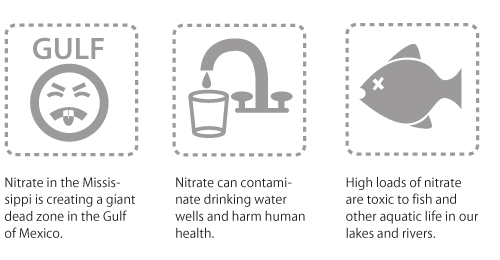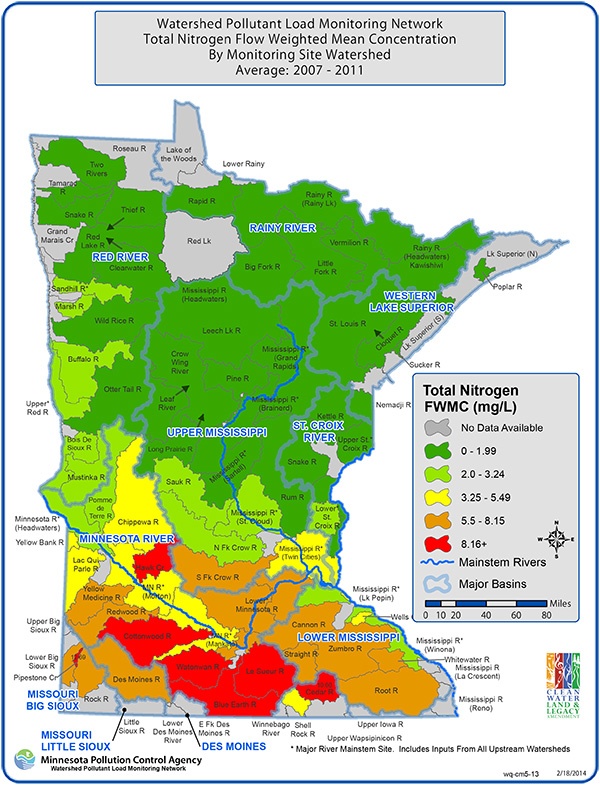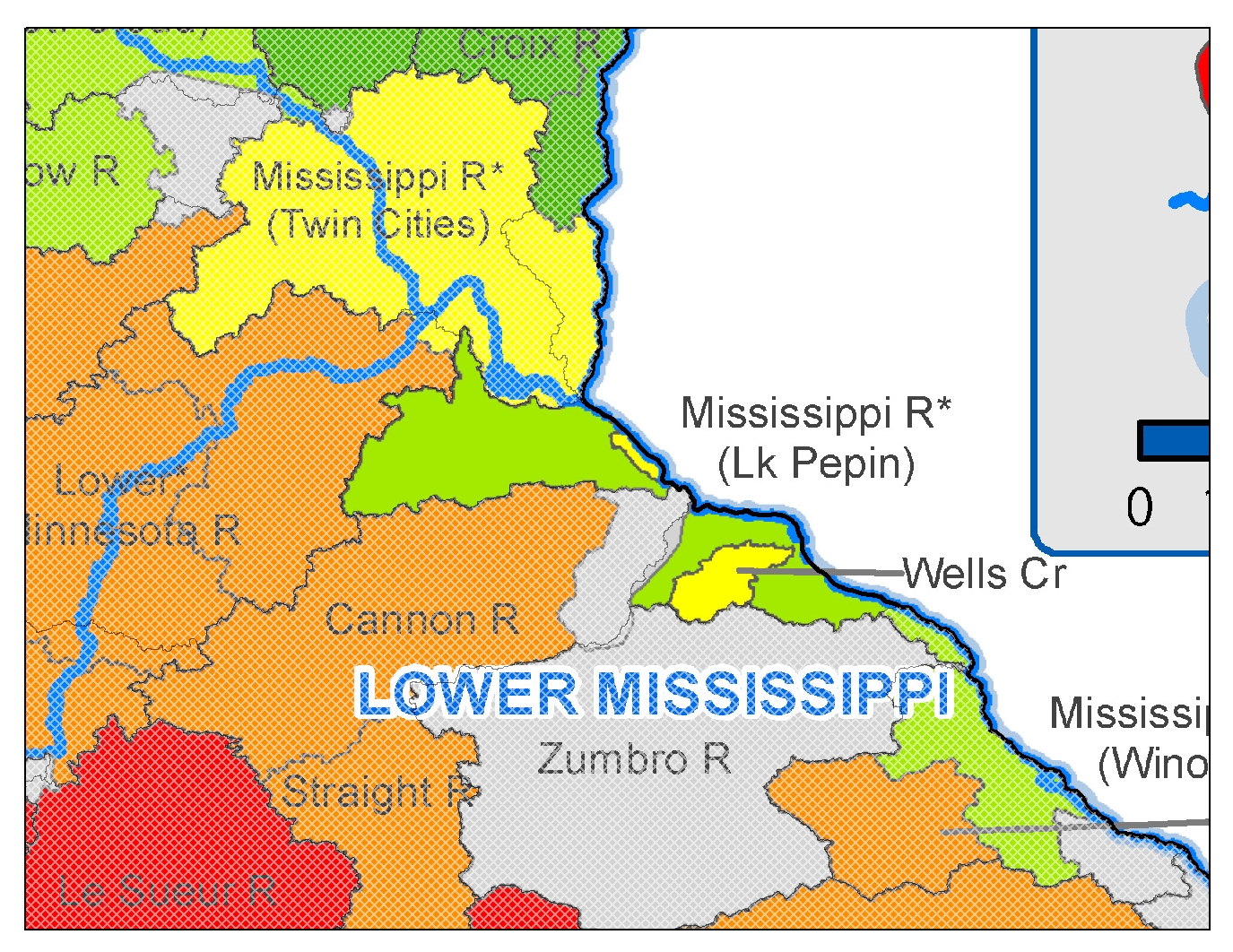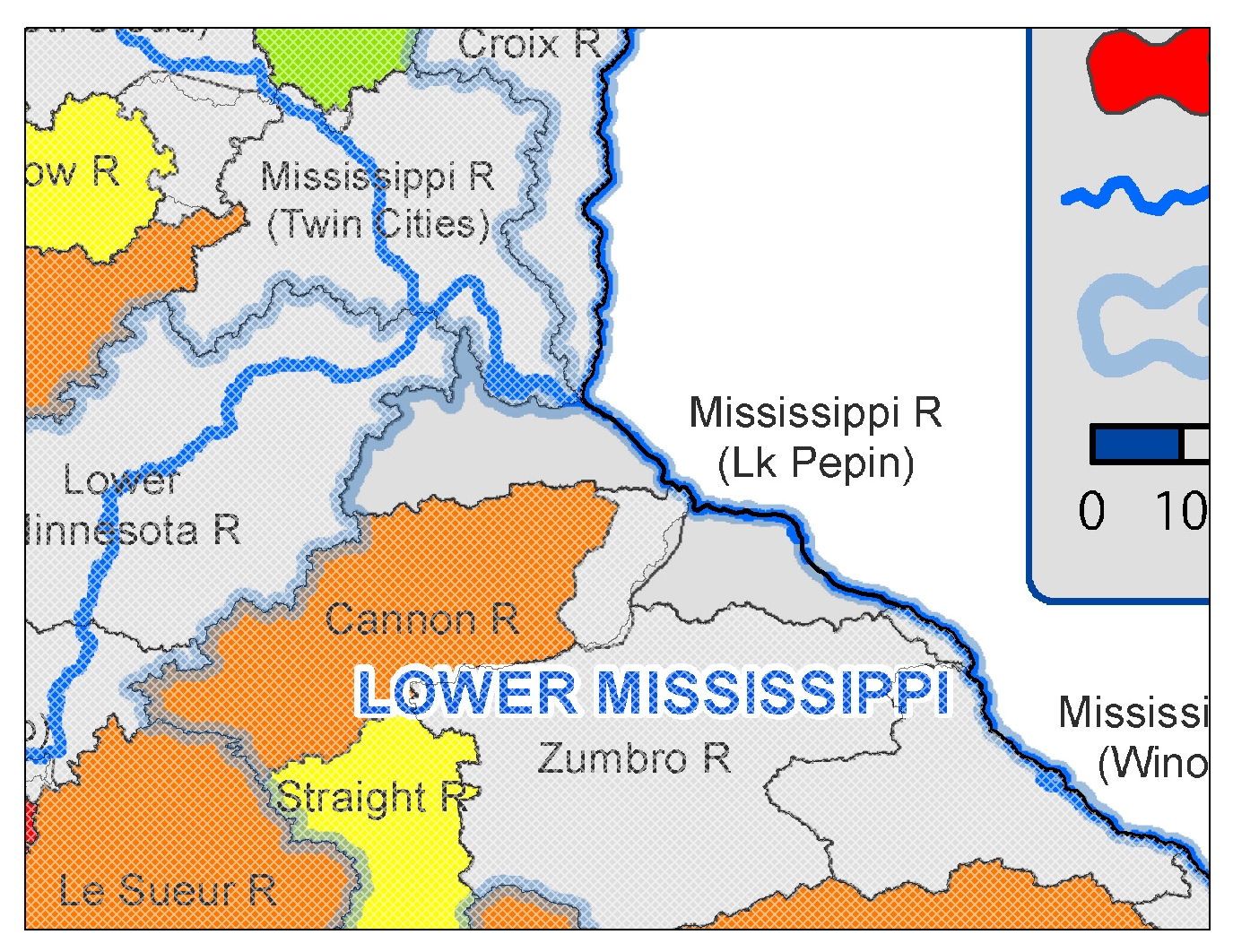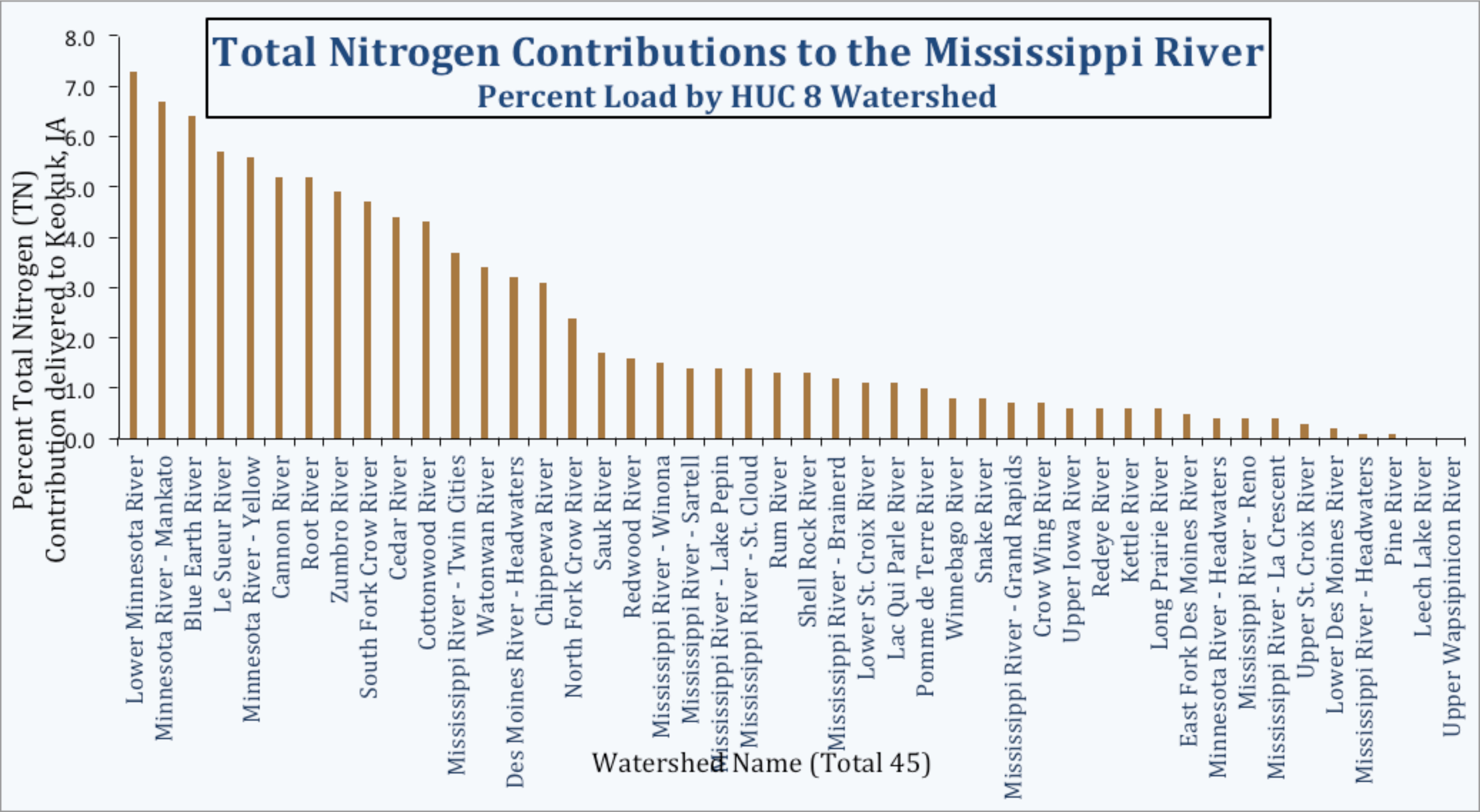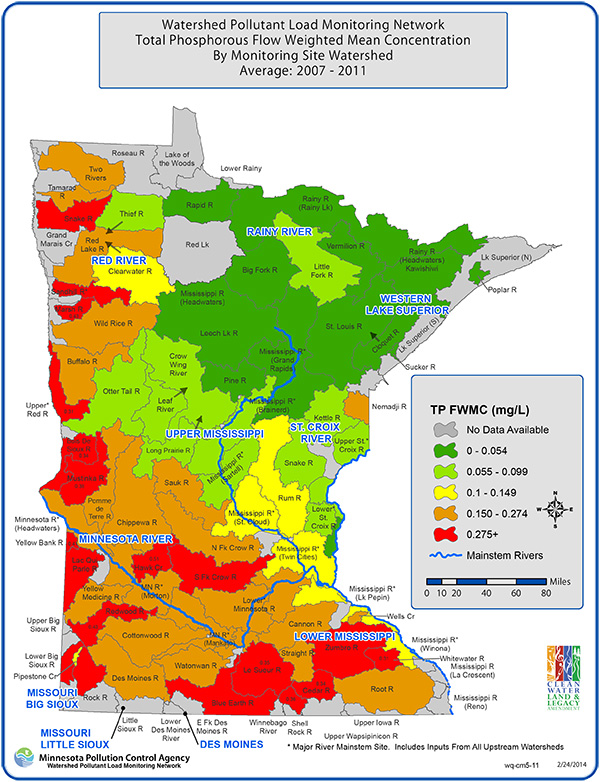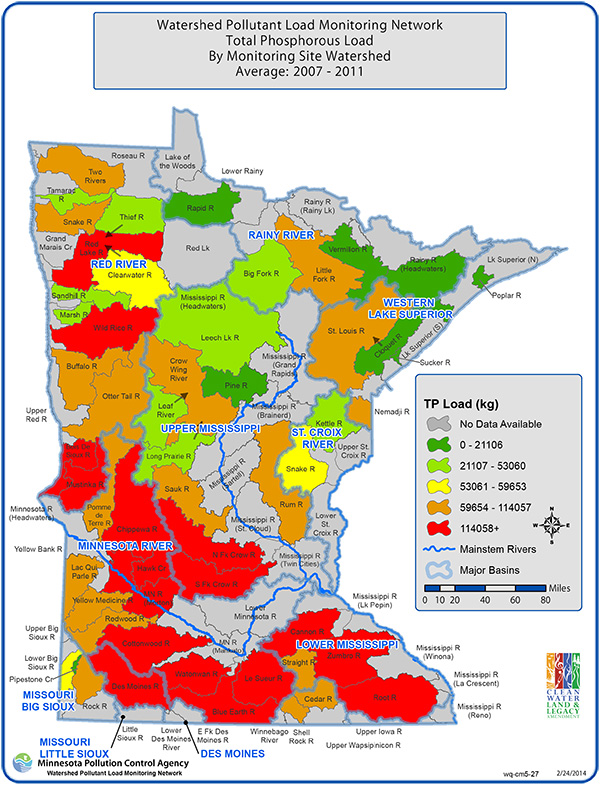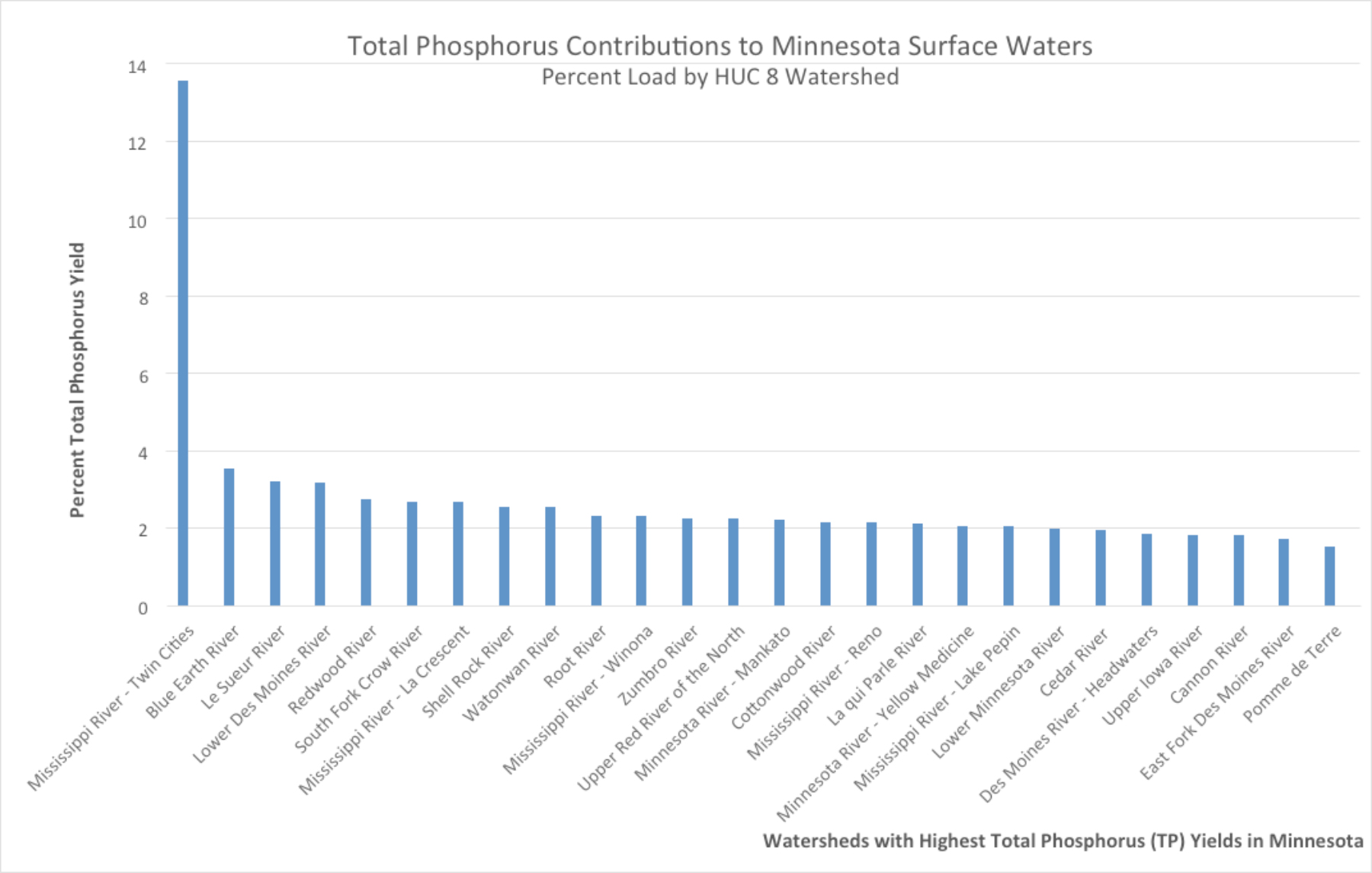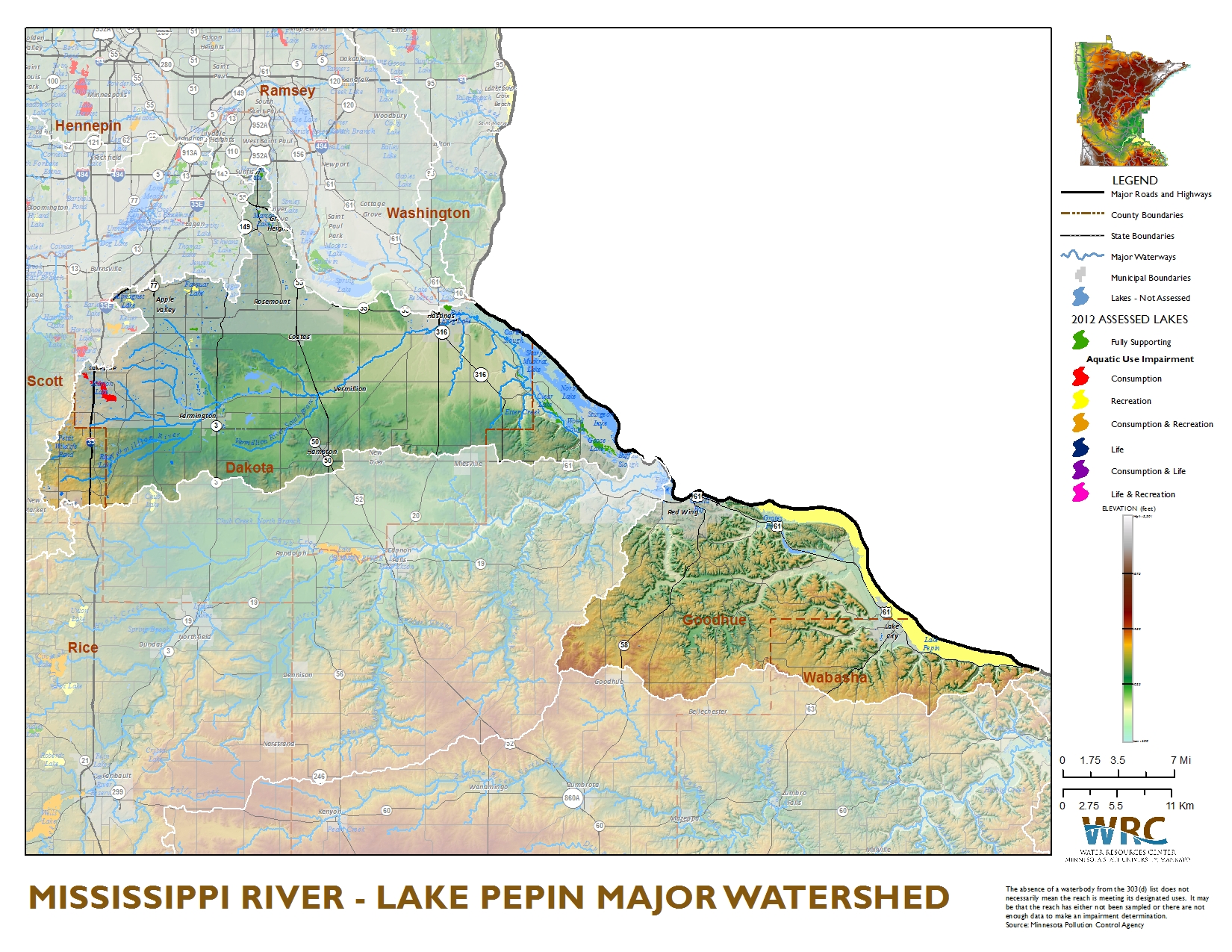Mississippi River - Lake Pepin
Overall Watershed Tabs
Vertical Tabs
Nitrogen (N) is one of the most widely distributed elements in nature and is present virtually everywhere on the earth’s crust in one or more of its many chemical forms. Nitrate (NO3), a mobile form of N, is commonly found in ground and surface waters throughout the country. Nitrate is generally the dominant form of N where total N levels are elevated. Nitrate and other forms of N in water can be from natural sources, but when N concentrations are elevated, the sources are typically associated with human activities (Dubrovski et al., 2010). Concerns about nitrate and total N in Minnesota’s water resources have been increasing due to effects of nitrate on certain aquatic life and drinking water supplies, along with increasing N in the Mississippi River and its impact on Gulf of Mexico oxygen depletion.
- Elevated nitrate levels harm fish and aquatic life.
- Because nitrate moves primarily via groundwater and tile drainage waters (not surface runoff), it can pollute drinking water wells.
- Nitrate leaving Minnesota via the Mississippi River contributes to the oxygen-depleted dead zone in the Gulf of Mexico.
Where does nitrate come from?
- More than 70% of the nitrate is coming from cropland, the rest from sources such as wastewater treatment plants, septic and urban runoff, forest, and the atmosphere.
- Municipal wastewater contributes 9% of the statewide nitrate load.
- Nitrate leaching into groundwater below cropped fields and moving underground until it reaches streams, contributes an estimated 30% of statewide nitrate to surface waters.
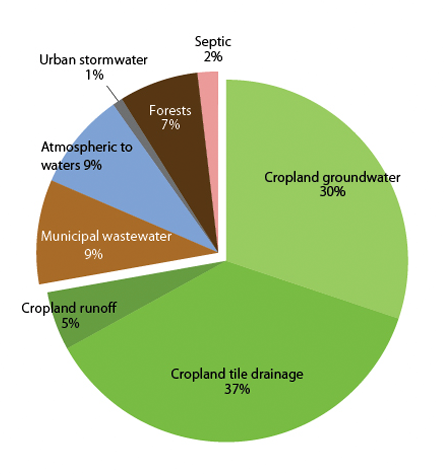
Source: Nitrogen in Minnesota Surface Waters (2013)
How does nitrate move from cropland into our water?
- The amount of nitrate reaching surface waters from cropland varies tremendously, depending on the type of crops, tile drainage practices, cropland management, soils, climate, geology and other factors.
- Tile drainage is the highest estimated cropland source pathway.
- Precipitation amounts have a pronounced effect on nitrate loads. During a dry year, loads may drop by 49% compared to an average year, however during a wet year, overall loads may increase by 51%.
- Nitrate concentrations and loads are high throughout much of southern Minnesota, resulting largely from leaching through large parts of intensively cropped soils and into underlying tile drains and groundwater.
- Cropland sources account for an estimated 89 to 95% of the nitrate load in the Minnesota, Missouri, and Cedar Rivers, and Lower Mississippi River basins.
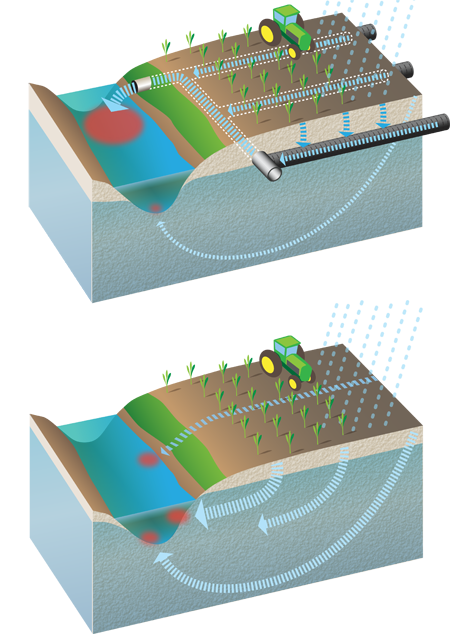 Source: Nitrogen in Minnesota Surface Waters (2013) Source: Nitrogen in Minnesota Surface Waters (2013) |
Tile drainage pathway |
Where does the nitrate go?
- Groundwater nitrate can take from hours to decades to reach surface waters.
- The highest nitrate-yielding watersheds are Cedar, Blue Earth and Le Sueur in south-central Minnesota.
- The Minnesota River adds twice as much nitrate to the Mississippi River as the combined loads from the Upper Mississippi and St. Croix Rivers.
- On average, 158 million pounds of nitrate leaves Minnesota per year in the Mississippi River — 75% comes from Minnesota watersheds.
- Nitrate concentrations have steadily increased in the Mississippi River since the mid-1970s.
-
Nitrate loads leaving Minnesota via the Mississippi River contribute to the oxygen-depleted “dead zone” in the Gulf of Mexico (currently estimated to be the size of Massachusetts). The dead zone cannot support aquatic life, affecting commercial and recreational fishing and the overall health of the Gulf.
How do we reduce the nitrate going into surface waters?
Tactics for reducing cropland nitrate going into surface waters fall into three categories:
- Manage in-field nutrients (i.e., optimize fertilizer rates, apply fertilizer closer to timing of crop use)
- Manage and treat tile drainage water (i.e., plan tile spacing and depth; control drainage; construct and restore wetlands for treatment purposes; and bioreactors)
- Diversify vegetation/landscape (i.e., plant cover crops; plant more perennials on marginal cropland, riparian zones and other areas)
Nitrate fertilizer efficiency has improved during the past two decades. While further refinements in fertilizer rates and application timing can be expected to reduce nitrate loads by roughly 13% statewide, additional and more costly practices will also be needed to make further reductions and meet downstream needs. Statewide reductions of more than 30% are not realistic with current practices.
To see progress, nitrate leaching reductions are needed across large parts of southern Minnesota, particularly on tile-drained fields and row crops over thin or sandy soils. Only collective incremental changes by many over broad acreages will result in significant nitrogen reductions to downstream waters.
Nitrogen is considered a limiting nutrient in the Gulf of Mexico, the body of water where much of Minnesota’s river and stream waters ultimately discharge. When nutrients in the Mississippi River originating in 31 states reach the Gulf of Mexico, a low oxygen “dead zone” known as hypoxia develops.
Hypoxia, which means low oxygen, occurs when excess nutrients, primarily N and P, stimulate algal growth in the Mississippi River and gulf waters. The algae and associated zooplankton grow well beyond the natural capacity of predators or consumers to maintain the plankton at a more balanced level. As the short-lived plankton die and sink to deeper waters, bacteria decompose the phytoplankton carbon, consuming considerable oxygen in the process. Water oxygen levels plummet, forcing mobile creatures like fish, shrimp, and crab to move out of the area. Less mobile aquatic life become stressed and/or dies.
The freshwater Mississippi River is less dense and warmer compared to the more dense cooler saline waters of the gulf. This results in a stratification of the incoming river waters and the existing gulf waters, preventing the mixing of the oxygen-rich surface water with oxygen-poor water on the bottom. Without mixing, oxygen in the bottom water is limited and the hypoxic zone remains. Hypoxia can persist for several months until there is strong mixing of the ocean waters, which can come from a hurricane or cold fronts in the fall and winter.
Hypoxic waters have dissolved oxygen concentrations of less than about 2-3 mg/l. Fish and shrimp species normally present on the ocean floor are not found when dissolved oxygen levels reduce to less than 2 mg/l. The Gulf of Mexico hypoxic zone is the largest in the United States and the second largest in the world. The maximum areal extent of this hypoxic zone was measured at 8,500 square miles during the summer of 2002. The average size of the hypoxic zone in the northern Gulf of Mexico in recent years (between 2004 and 2008) has been about 6,500 square miles, the size of Lake Ontario.
Hypoxia Task Force
A multi-state Hypoxia Task Force (which includes Minnesota) released their first Action Plan in 2001. This plan was reaffirmed and updated in a 2008 Action Plan. The Hypoxia Task Force established a collaborative interim goal to reduce the 5-year running average areal extent of the Gulf of Mexico hypoxic zone to less than 5,000 square kilometers (1,931 square miles). Further information about Gulf of Mexico hypoxia can be found at: https://gulfhypoxia.net/
A thorough technical discussion of the research associated with Gulf of Mexico hypoxia and possible nutrient reduction options is presented by the US EPA (2007). The report notes that P may be more influential than N in the near-shore gulf water algae growth, particularly in the spring months, when algae and phytoplankton growth are often greatest. In the transition months between spring and summer, the algae and phytoplankton growth are controlled largely by the coupling of P and N. Nitrogen typically becomes the controlling nutrient in the summer and fall months. Based on these more recent findings, emphasis has shifted to developing strategies for dual nutrient removal (P and N). The Science Advisory Board recommends a 45% reduction in riverine TP and TN loads into the Gulf of Mexico (US EPA 2007).
Minnesota’s Contribution to Gulf Hypoxia
Certain areas of Minnesota release large quantities of N and P to Minnesota streams. Much of the nutrients remain in the Mississippi River system, ultimately reaching the Gulf of Mexico. Alexander et al. (2008) used computer modeling (SPARROW) to estimate the proportion of gulf nutrients originating in different geographic areas. The model accounted for the loss of nutrients in the river, river pools, and backwaters prior to reaching the Gulf of Mexico. This modeling indicated that Minnesota contributed 3% of Gulf of Mexico N and 2% of the P. However, with more recent SPARROW modeling, Minnesota’s contribution is estimated to be higher, ranking as the sixth highest state for N contributions behind Iowa, Illinois, Indiana, Ohio, and Missouri. The more recent modeling estimates indicate that Minnesota is responsible for about 6% of the N loading and 4% of the P loading into the Gulf of Mexico (Robertson, 2012 personal communication).
Recognizing that it will take a concerted effort by all states which contribute significant amounts of nutrients to the gulf, the MPCA agreed with other top nutrient contributing states to complete and implement a comprehensive N and P reduction strategy. This plan was completed in 2014 (Mississippi River/Gulf of Mexico Watershed Nutrient Task Force, 2008). The goal of the Action Plan is to reduce nutrients to the Gulf of Mexico while at the same time addressing in-state water protection and restoration.
Minnesota Nitrogen Study
The MPCA conducted a study of nitrogen in surface waters so that we can better understand the nitrogen conditions in Minnesota’s surface waters, along with the sources, pathways, trends and potential ways to reduce nitrogen in waters.
Excerpts from Nitrogen in Minnesota Surface Waters
![]() Sources of Nitrogen - Results Overview
Sources of Nitrogen - Results Overview
![]() Sources of Nitrogen - Wastewater Point Source Nitrogen Loads
Sources of Nitrogen - Wastewater Point Source Nitrogen Loads
![]() Sources of Nitrogen - Atmospheric Deposition of Nitrogen in Minnesota Watersheds
Sources of Nitrogen - Atmospheric Deposition of Nitrogen in Minnesota Watersheds
Statewide - N Sources to Waters - Average Year
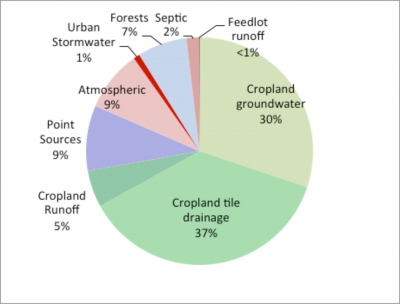
Source: Nitrogen in Minnesota Surface Waters, Sources of Nitrogen - Results Overview (2013)
Cropland sources contribute an estimated 73 percent of the statewide N load during an average precipitation year. Cropland nitrogen is primarily delivered to surface waters through subsurface pathways of tile drainage and groundwater.
Lower Mississippi River Basin - N Sources to Surface Waters
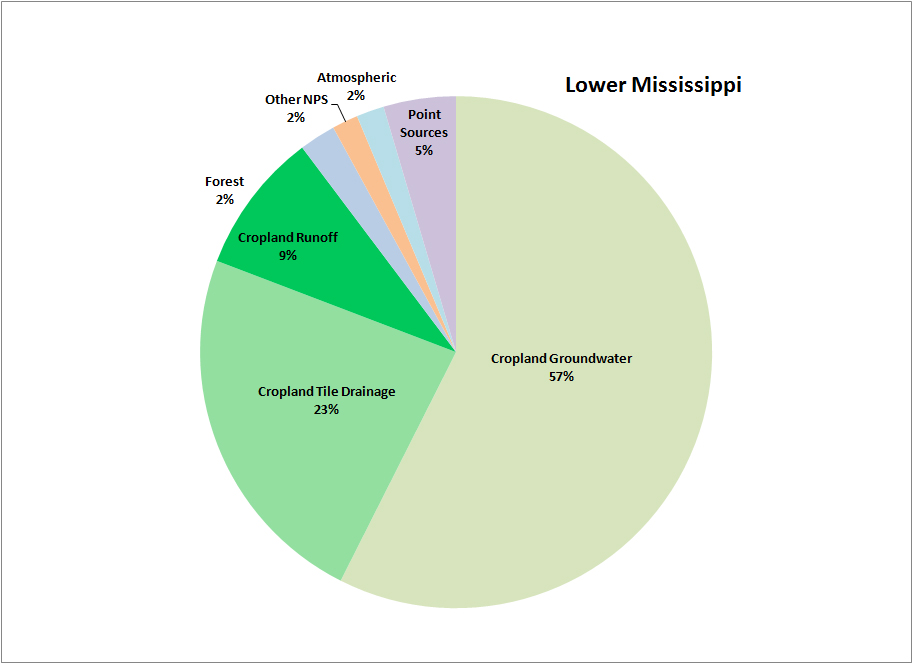
Source: Nitrogen in Minnesota Surface Waters, Sources of Nitrogen - Results Overview (2013)
Statewide - N Sources to Surface Waters Chart -Average Year
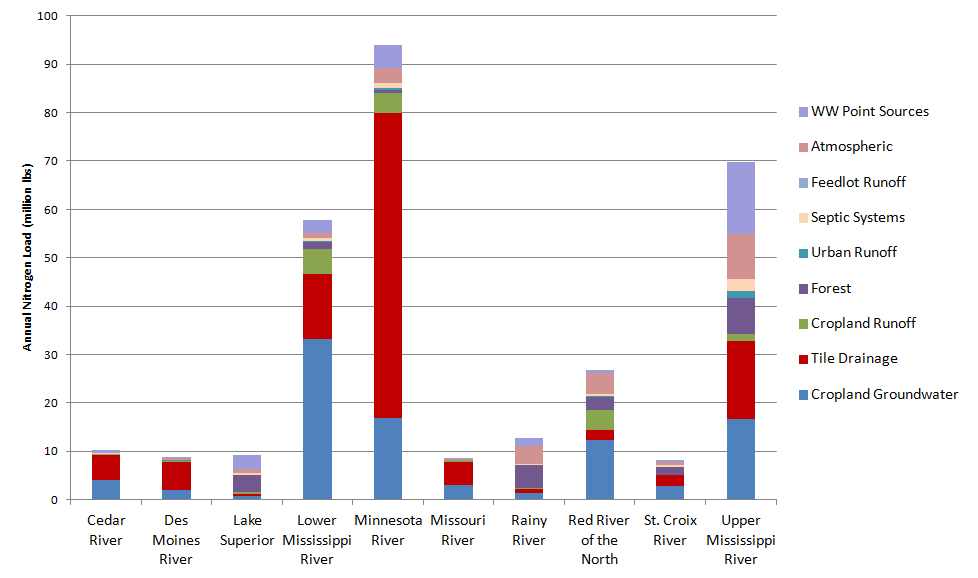
Source: Nitrogen in Minnesota Surface Waters, Sources of Nitrogen - Results Overview (2013)
Estimated N loads to surface waters from different sources within the Minnesota portions of major basins during an average precipitation year. “Ag” represents cropland sources.
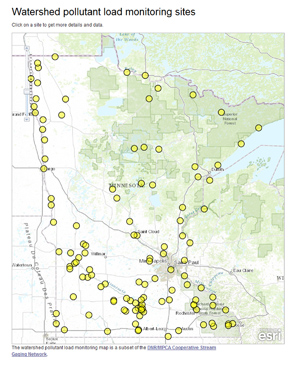
 Watershed Pollutant Load Monitoring Network - MPCA
Watershed Pollutant Load Monitoring Network - MPCA
Water Quality Databases
 DNR/MPCA Cooperative Stream Gaging Network – USGS, DNR, MPCA – Stream discharge and links to Division of Waters Resources, climate information, river levels, water quality information, recreation and commonly used hydrologic terms
DNR/MPCA Cooperative Stream Gaging Network – USGS, DNR, MPCA – Stream discharge and links to Division of Waters Resources, climate information, river levels, water quality information, recreation and commonly used hydrologic terms
 USGS – USGS discharge Information
USGS – USGS discharge Information
 EDA Environmental Data Access – Water quality data collected for all MPCA monitoring projects
EDA Environmental Data Access – Water quality data collected for all MPCA monitoring projects
 EQuIS – Environmental Quality Information System – Water quality data from more than 17,000 sampling locations across the state.
EQuIS – Environmental Quality Information System – Water quality data from more than 17,000 sampling locations across the state.
|
|
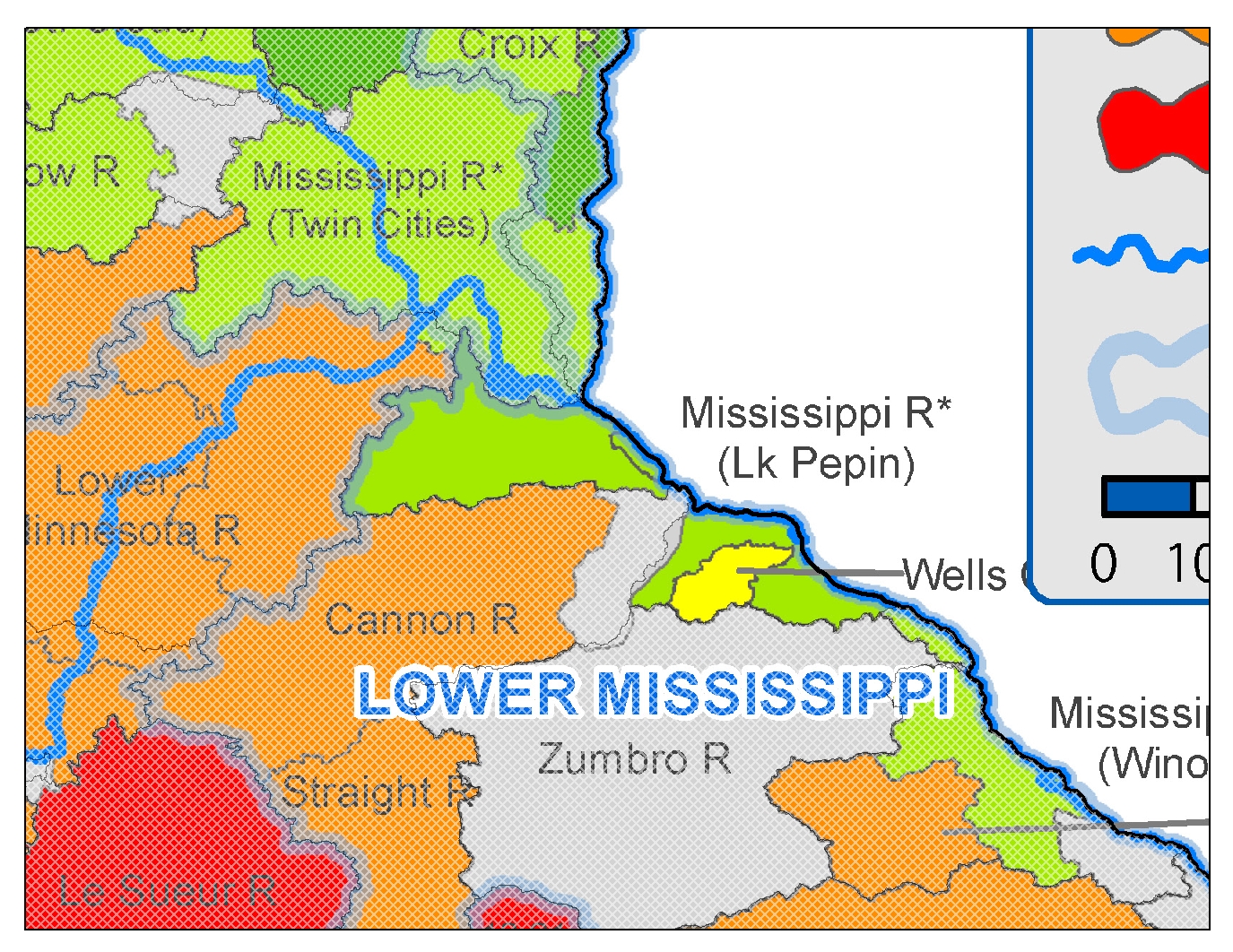 |
Source: Watershed Pollutant Load Monitoring Network - MPCA (2014)
Average annual flow-weighted mean concentrations for Total Nitrogen near watershed outlets based on annual averages derived from available information collected in 2007-11.
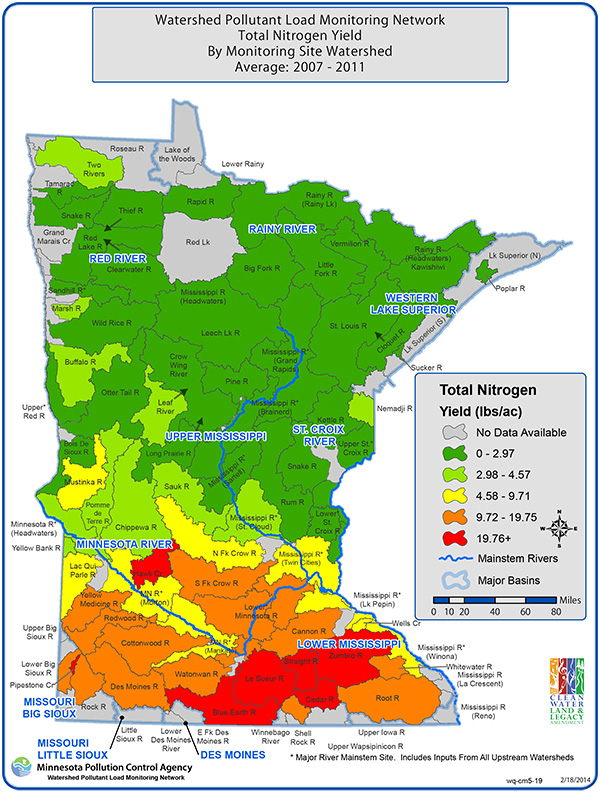 |
|
Source: Watershed Pollutant Load Monitoring Network - MPCA (2014)
Average annual yield (lbs/acre) for Total Nitrogen near watershed outlets based on annual averages derived from available information collected in 2007-11.
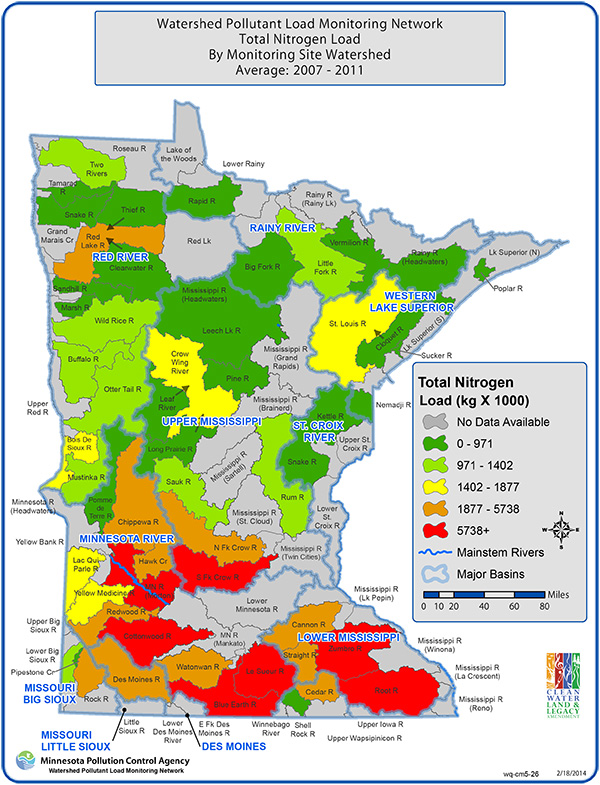 |
|
Source: Watershed Pollutant Load Monitoring Network - MPCA (2014)
Average annual Total Nitrogen Load near watershed outlets based on annual averages derived from available information collected in 2007-11.
Excerpts from  Nitrogen in Minnesota Surface Waters - MPCA
Nitrogen in Minnesota Surface Waters - MPCA
![]() Chapter 4: Modeled Nitrogen Loads (SPARROW)
Chapter 4: Modeled Nitrogen Loads (SPARROW)
The MPCA’s Nitrogen Study shows elevated nitrate levels, particularly in the southern third of Minnesota.
 |
 |
Source: Nitrogen in Minnesota Surface Waters, Chapter 4: Modeled Nitrogen Loads (SPARROW) (2013)
Data Source: SPARROW flow-weighted mean TN concentration by HUC8 watersheds. The value represents the median FWMC of all subwatershed catchments within the HUC8 watersheds.
SPARROW Modeling for the Zumbro River Watershed indicated average flow-weighted mean TN concentration of 4.09 mg/l. This value represents the median FWMC of all subwatershed catchments within the Zumbro River Watershed.
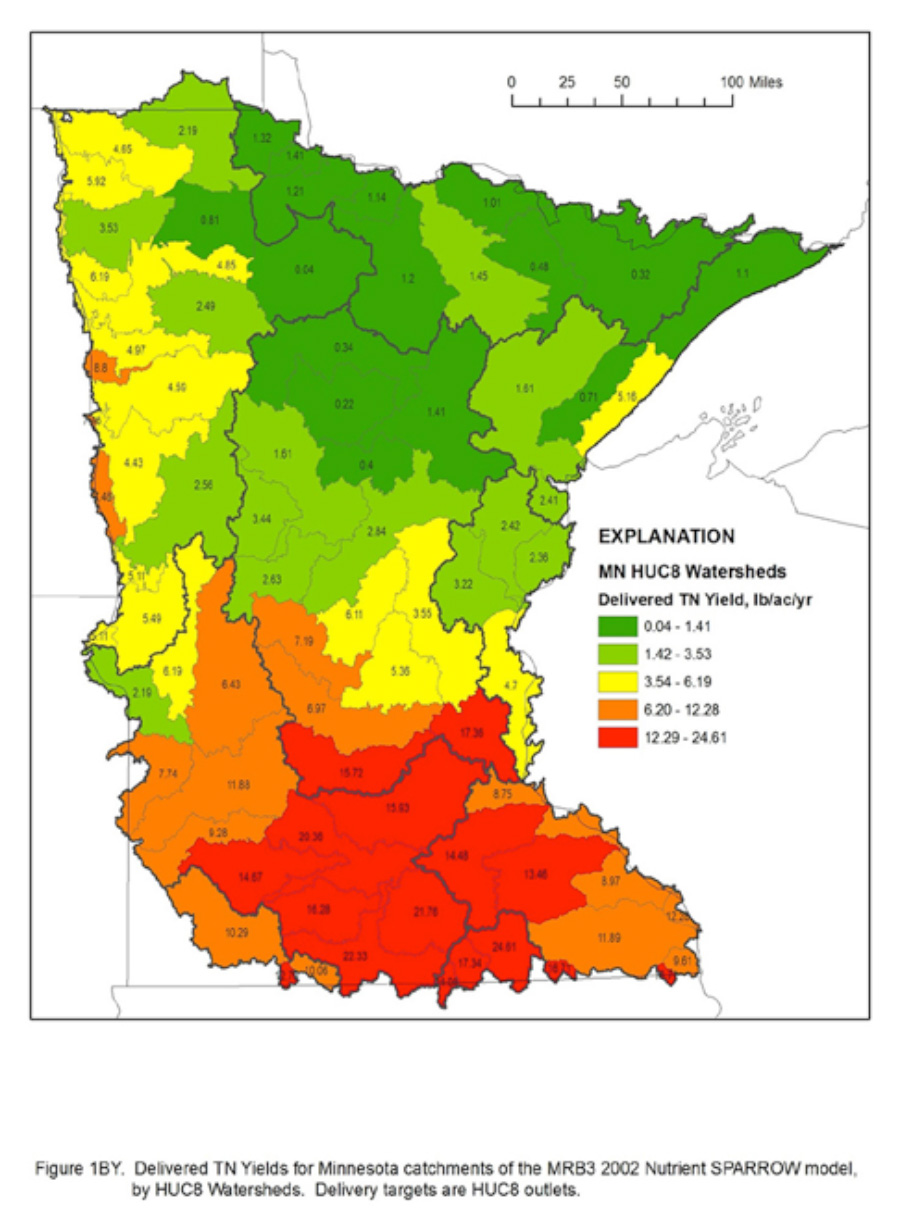 |
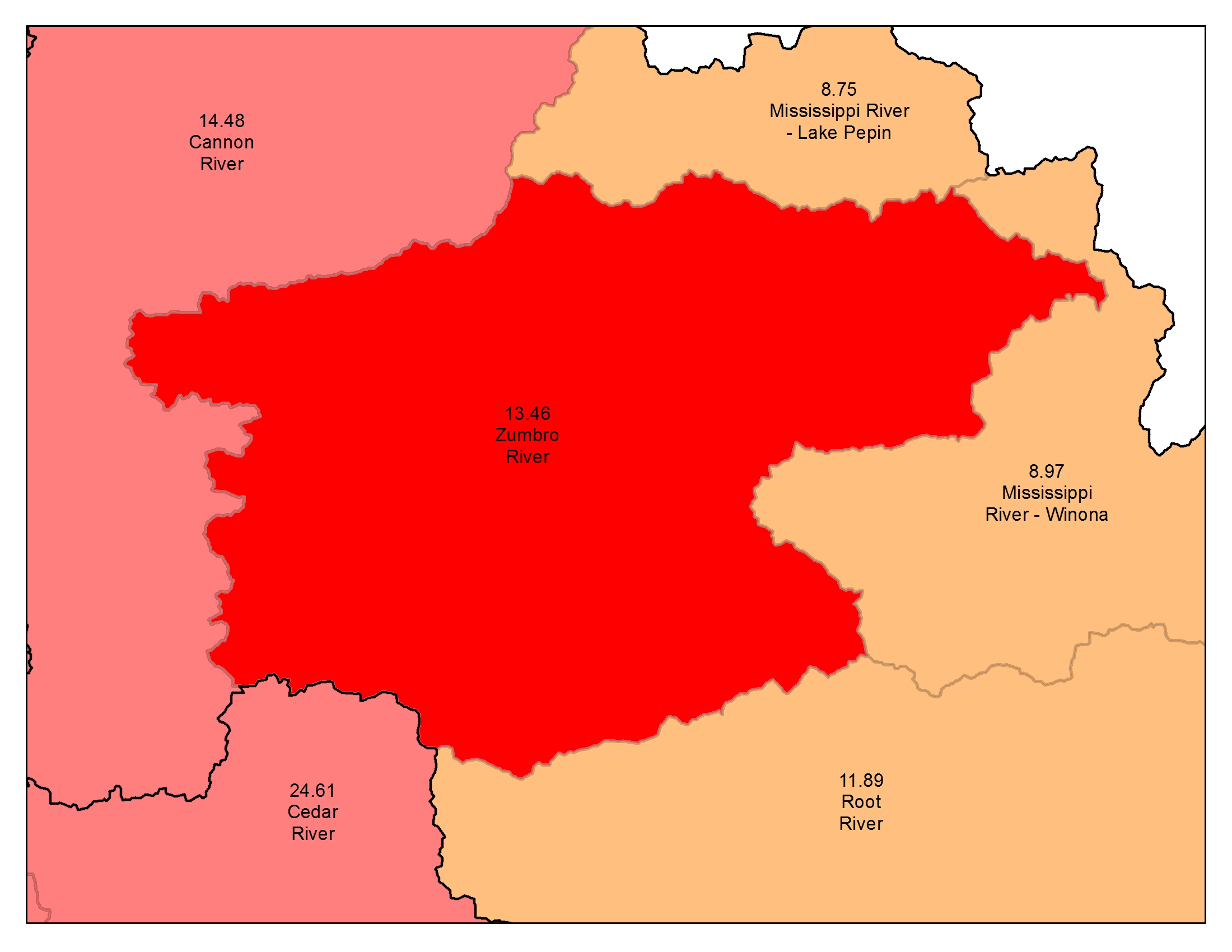 |
Source: Nitrogen in Minnesota Surface Waters, Chapter 4: Modeled Nitrogen Loads (SPARROW) (2013)
SPARROW model annual TN yield results by HUC8 watershed in lbs/acre/year. The basin yields represent the total load delivered to the watershed outlet or state border divided by the sum of the SPARROW (MRB3 2002) catchment area.
SPARROW model annual TN yield results for the Zumbro River Watershed was 8.75 lbs/acre/year.
Statewide Comparison of Nitrate+Nitrate-N Yields (lbs/ac)
|
|
Nitrite+Nitrate-N |
|
S. Central |
11-19 |
|
Southeast |
8-9 |
|
Southwest |
4-9 |
|
Central |
1-2 |
|
Northwest |
0.1-1 |
|
Northeast |
0.1-2 |
Source: Nitrogen in Minnesota Surface Waters (2013)
Total Nitrogen Contributions to the Mississippi River (percent Load by HUC8 Watershed)
Source: Nitrogen in Minnesota Surface Waters, 2013
Percent contribution of TN delivered to the Mississippi River in Keokuk, Iowa, from each of Minnesota’s HUC8 Watersheds which ultimately drain into the Mississippi River. Each bar represents the percent TN originating from a single watershed, from highest contributor (left) to lowest contributor (right).
Fifteen of the 45 watersheds draining into the Mississippi River from Minnesota each contribute over 3 percent of the modeled load delivered to the Mississippi River in southern Iowa (Keokuk) (Table 4 and Figure 9). Combined, these 15 watersheds contribute 73.7 percent of the total nitrogen load delivered to Keokuk from Minnesota (Figure 10). These higher loading watersheds are mostly located in South-central and southeastern Minnesota. The other thirty watersheds each contribute between 0 and 2.4 percent of the load, and are thus considered relatively minor contributors.
|
WS # |
Watershed Name |
% load contribution |
|
33 |
Lower Minnesota River |
7.3 |
|
28 |
Minnesota River - Mankato |
6.7 |
|
30 |
Blue Earth River |
6.4 |
|
32 |
Le Sueur River |
5.7 |
|
25 |
Minnesota River - Yellow Medicine River |
5.6 |
|
39 |
Cannon River |
5.2 |
|
43 |
Root River |
5.2 |
|
41 |
Zumbro River |
4.9 |
|
19 |
South Fork Crow River |
4.7 |
|
48 |
Cedar River |
4.4 |
|
29 |
Cottonwood River |
4.3 |
|
20 |
Mississippi River - Twin Cities |
3.7 |
|
31 |
Watonwan River |
3.4 |
|
51 |
Des Moines River - Headwaters |
3.2 |
|
26 |
Chippewa River |
3.1 |
|
18 |
North Fork Crow River |
2.4 |
|
16 |
Sauk River |
1.7 |
|
27 |
Redwood River |
1.6 |
|
40 |
Mississippi River - Winona |
1.5 |
|
15 |
Mississippi River - Sartell |
1.4 |
|
38 |
Mississippi River - Lake Pepin |
1.4 |
|
17 |
Mississippi River - St. Cloud |
1.4 |
|
21 |
Rum River |
1.3 |
|
49 |
Shell Rock River |
1.3 |
|
10 |
Mississippi River - Brainerd |
1.2 |
|
37 |
Lower St. Croix River |
1.1 |
|
24 |
Lac Qui Parle River |
1.1 |
|
23 |
Pomme de Terre River |
1.0 |
|
50 |
Winnebago River |
0.8 |
|
36 |
Snake River |
0.8 |
|
9 |
Mississippi River - Grand Rapids |
0.7 |
|
12 |
Crow Wing River |
0.7 |
|
46 |
Upper Iowa River |
0.6 |
|
13 |
Redeye River |
0.6 |
|
35 |
Kettle River |
0.6 |
|
14 |
Long Prairie River |
0.6 |
|
53 |
East Fork Des Moines River |
0.5 |
|
22 |
Minnesota River - Headwaters |
0.4 |
|
44 |
Mississippi River - Reno |
0.4 |
|
42 |
Mississippi River - La Crescent |
0.4 |
|
34 |
Upper St. Croix River |
0.3 |
|
52 |
Lower Des Moines River |
0.2 |
|
7 |
Mississippi River - Headwaters |
0.1 |
|
11 |
Pine River |
0.1 |
|
8 |
Leech Lake River |
0.0 |
|
47 |
Upper Wapsipinicon River |
0.0 |
Source: Nitrogen in Minnesota Surface Waters, 2013
Statewide Nitrate Trends
Excerpts from  Nitrogen in Minnesota Surface Waters
Nitrogen in Minnesota Surface Waters
![]() Nitrate Trends in Minnesota Rivers
Nitrate Trends in Minnesota Rivers
![]() Nitrogen Trend Results from Previous Studies
Nitrogen Trend Results from Previous Studies
Nitrate Trends in Tributaries of the Lower Mississippi River
The three tributaries analyzed for trends in the Lower Mississippi River Basin all had downward trends in flow-adjusted nitrate concentrations between about 2003-05 and 2010 (Table 6). During the decade prior to that, all three sites had upward trends. Since 1976, the overall change in the Zumbro River has been a 38% increase. The Straight River had periods of increases and decreases, which have amounted to virtually no overall change (-4%). Many tributaries to the Lower Mississippi River from both the Minnesota and Wisconsin side of the basin were not analyzed for trends because the combination of flow and monitoring data were not available. See Nitrate Trends in Minnesota Rivers and Nitrogen Trend Results from Previous Studies for more information.
Source: Nitrogen in Minnesota Surface Waters, Nitrate Trends in Minnesota Rivers (2013)
Vertical Tabs
Phosphorus is the nutrient primarily responsible for the eutrophication (nutrient enrichment of waterbodies) of Minnesota’s surface waters. Phosphorus is an essential nutrient for plants, animals and humans. It is one of the 20 most abundant elements in the solar system, and the 11th most abundant in the earth’s crust. Under natural conditions phosphorus (P) is typically scarce in water. Human activities, however, have resulted in excessive loading of phosphorus into many freshwater systems. This can cause water pollution by promoting excessive algae growth, particularly in lakes. Lakes that appear relatively clear in spring can resemble green soup in late summer due to algae blooms fueled by phosphorus. Water quality can be further impaired when bacteria consume dead algae and use up dissolved oxygen,suffocating fish and other aquatic life.
An overabundance of phosphorus—specifically usable (bioavailable) phosphorus—results in excessive algal production in Minnesota waters. Phosphorus from point sources may be more bioavailable, impacting surface water quality more than a similar amount of nonpoint source phosphorus that enters the same surface water conditions. Total phosphorus levels of 100 or more ppb categorize lakes as highly eutrophic, with high nutrient and algae levels.
In some water bodies, the concentration of phosphorus is low enough to limit the growth of algae and/or aquatic plants. In this case, scientists say phosphorus is the limiting nutrient. For example, in water bodies having total phosphorus concentrations less than 10 parts per billion (1 ppb – equal to one drop in a railroad tank car), waters will be nutrient-poor and will not support large quantities of algae and aquatic plants.
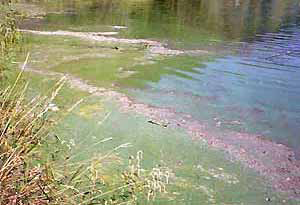
MPCA
Phosphorus contributions to Minnesota surface waters by point and nonpoint sources are known to vary, both geographically and over time, in response to annual variations in weather and climate. Nonpoint sources of phosphorus tend to comprise a larger fraction of the aggregate phosphorus load to Minnesota surface waters during relatively wet periods, while point sources become increasingly important during dry periods.
Minnesota River Basin-Lake Pepin
Three major river basins empty into Lake Pepin in southeastern Minnesota – St. Croix, Upper Mississippi, and the Minnesota. Lake Pepin is listed as an impaired water due to sediment and eutrophication (excessive nutrients and algae). The Minnesota River contributes a majority of the sediment. In a highly turbid water body such as the Minnesota River, much of the phosphorus load is attached to eroded soil particles, especially at higher flows. Much of the particulate phosphorus in the Minnesota River converts to the soluble that can become available to algae. This occurs in several ways: chemical and physical change (diagenesis) of sediment in the river or lake bed, interaction with dissolved chemicals in the water, and decay of organic P releasing dissolved phosphorus from soil particles. Models being used in the Lake Pepin and Minnesota River Total Maximum Daily Load projects keep track of both particulate and dissolved forms of phosphorus.
The Minnesota Pollution Control Agency is currently developing new water quality standards for River Eutrophication and Total Suspended Solids. Visit the MPCA website for more information.
Sources:
 Minnesota Nutrient Reduction Strategy - MPCA
Minnesota Nutrient Reduction Strategy - MPCA
 Phosphorus: Sources, Forms, Impacts on Water Quality - MPCA
Phosphorus: Sources, Forms, Impacts on Water Quality - MPCA
 New Water Quality Standards for River Eutrophication and Total Suspended Solids - MPCA
New Water Quality Standards for River Eutrophication and Total Suspended Solids - MPCA
Excerpts From Minnesota Nutrient Reduction Strategy
 Chapter 5 Point and Nonpoint Source Reductions (2013)
Chapter 5 Point and Nonpoint Source Reductions (2013)
 Detailed Assessment of Phosphorus Sources to Minnesota Watersheds (2004)
Detailed Assessment of Phosphorus Sources to Minnesota Watersheds (2004)
![]() Summary of Phosphorus Loading by Basin (2004)
Summary of Phosphorus Loading by Basin (2004)
Statewide Phosphorus Sources, Average Year

Source: Minnesota Nutrient Reduction Strategy, Chapter 5 Point and Nonpoint Source Reductions (2013)
Under normal water flows, roughly two- thirds of the total phosphorus load to lakes and rivers comes from nonpoint sources such as runoff from pasture and croplands, atmospheric deposition and stream bank erosion. Phosphorus loading contributed by runoff from pastures and croplands is largest source of nonpoint phosphorus on a statewide basis. Other nonpoint sources include urban runoff, non-agricultural rural runoff and seepage from individual sewage treatment systems.
Approximately 30 percent of the phosphorus load to Minnesota waters comes from point sources such as municipal and industrial wastewater treatment facilities. The magnitude of various sources of phosphorus varies greatly throughout the state due to the diverse nature of Minnesota’s watersheds.
Mississippi River
Phosphorus Sources to Surface Waters
Current: Average Precipitation Year

Source: Minnesota Nutrient Reduction Strategy (2013)
Pollutant Load Monitoring Sites in Minnesota
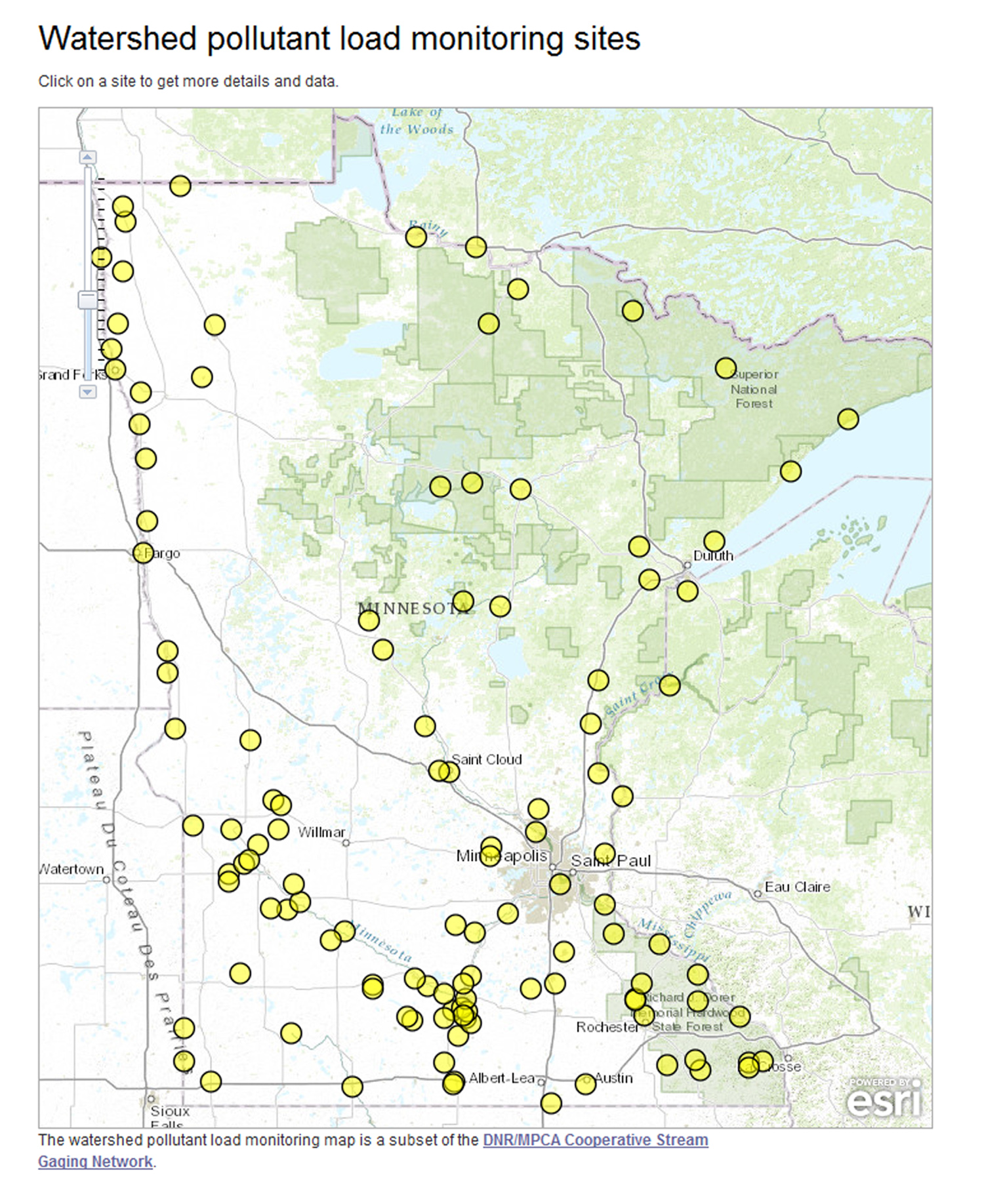
 Watershed Pollutant Load Monitoring Network - MPCA
Watershed Pollutant Load Monitoring Network - MPCA
Water Quality Databases
 DNR/MPCA Cooperative Stream Gaging Network – USGS, DNR, MPCA – Stream discharge and links to Division of Waters Resources, climate information, river levels, water quality information, recreation and commonly used hydrologic terms
DNR/MPCA Cooperative Stream Gaging Network – USGS, DNR, MPCA – Stream discharge and links to Division of Waters Resources, climate information, river levels, water quality information, recreation and commonly used hydrologic terms
 USGS – USGS discharge Information
USGS – USGS discharge Information
 EDA Environmental Data Access – Water quality data collected for all MPCA monitoring projects
EDA Environmental Data Access – Water quality data collected for all MPCA monitoring projects
 EQuIS – Environmental Quality Information System – Water quality data from more than 17,000 sampling locations across the state.
EQuIS – Environmental Quality Information System – Water quality data from more than 17,000 sampling locations across the state.
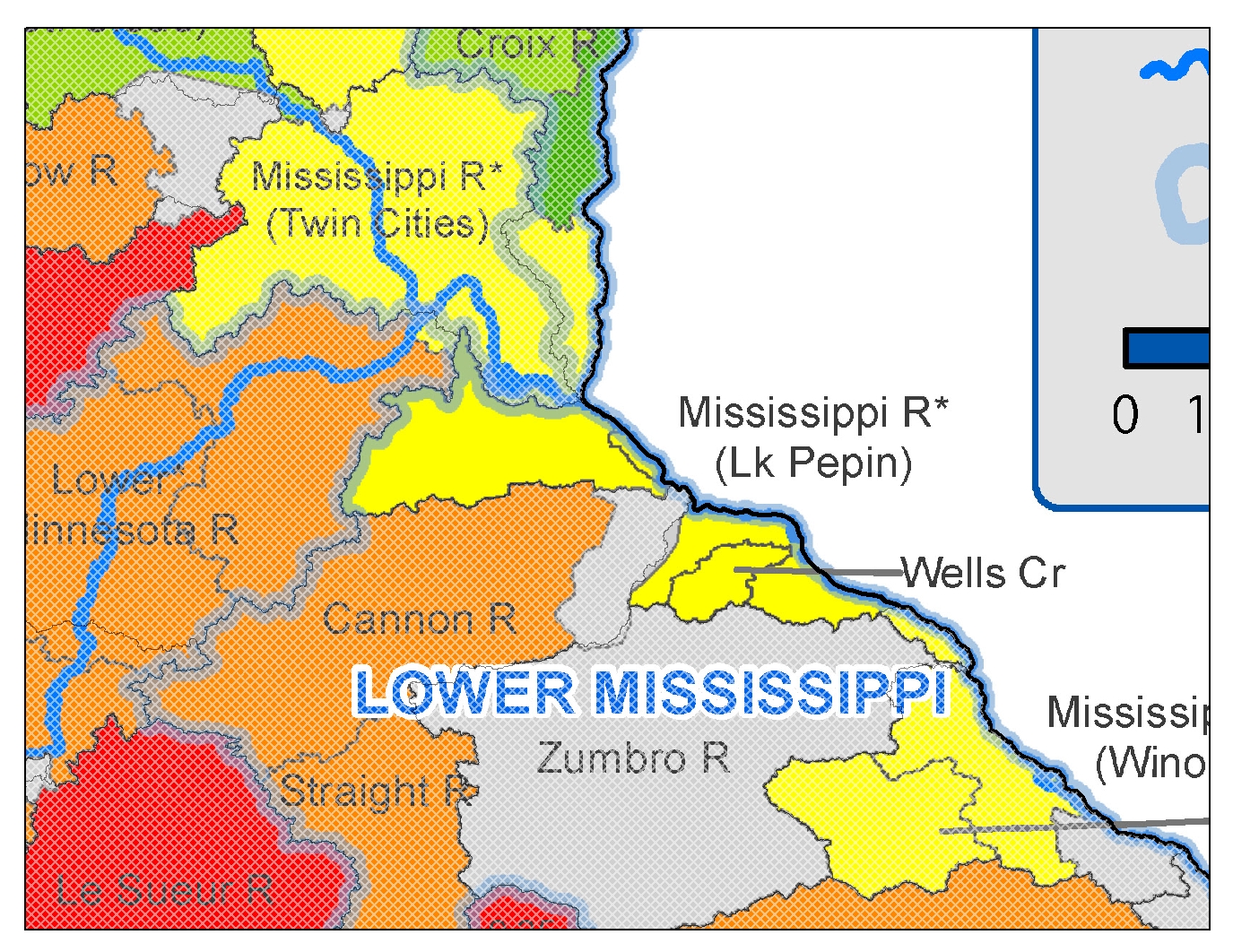 |
Source: Watershed Pollutant Load Monitoring Network - MPCA (2014)
Average annual flow-weighted mean concentrations (mg/L) for Total Phosphorus near watershed outlets based on yearly averages derived from available information collected in 2007-011.
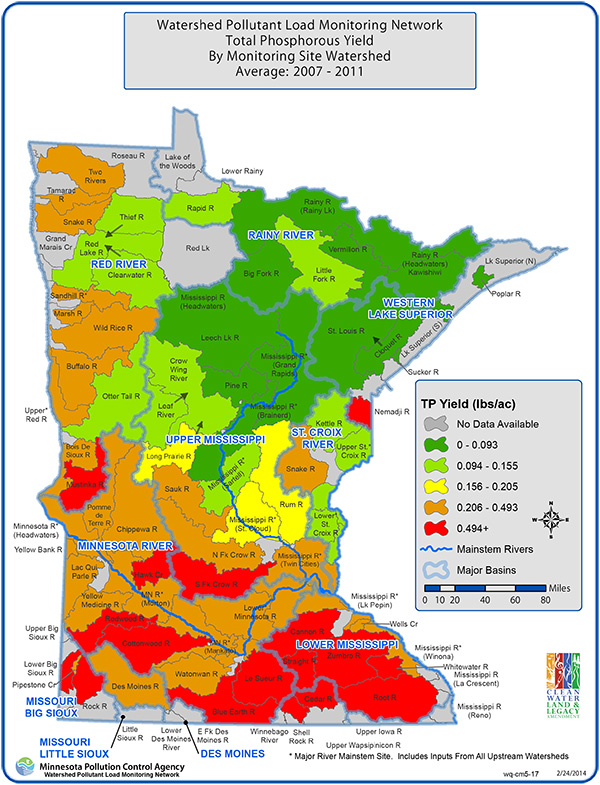 |
|
Source: Watershed Pollutant Load Monitoring Network - MPCA (2014)
Average annual Total Phosphorus Yield (lbs/acre) near watershed outlets based on yearly averages derived from available information collected in 2007-011.
 |
Source: Watershed Pollutant Load Monitoring Network - MPCA (2014)
Average annual Total Phosphorus Load (kg) near watershed outlets based on yearly averages derived from available information collected in 2007-011.
SPARROW modeling
The SPAtially Referenced Regressions on Watershed attributes (SPARROW) model, developed and maintained by the United States Geological Survey (USGS), was used for the Minnesota Nutrient Reduction Strategy to estimate Total Phosphorus (TP) loads, yields, and flow-weighted mean concentrations (FWMC) in Minnesota 8-digit Hydrologic Unit Code (HUC8) watersheds and major basins.
Modeling Total Phosphorus Yield (lb/ac/yr)
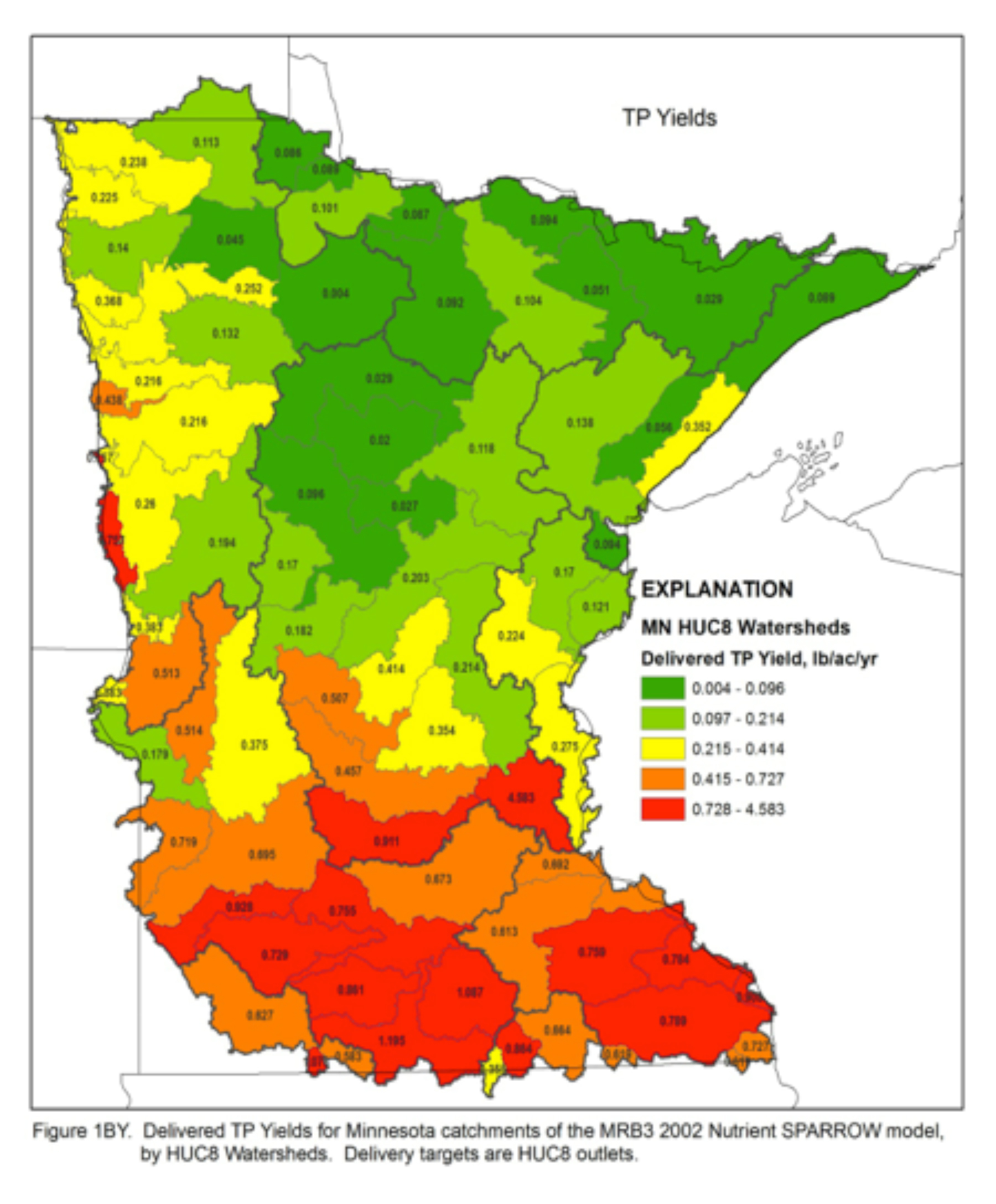 |
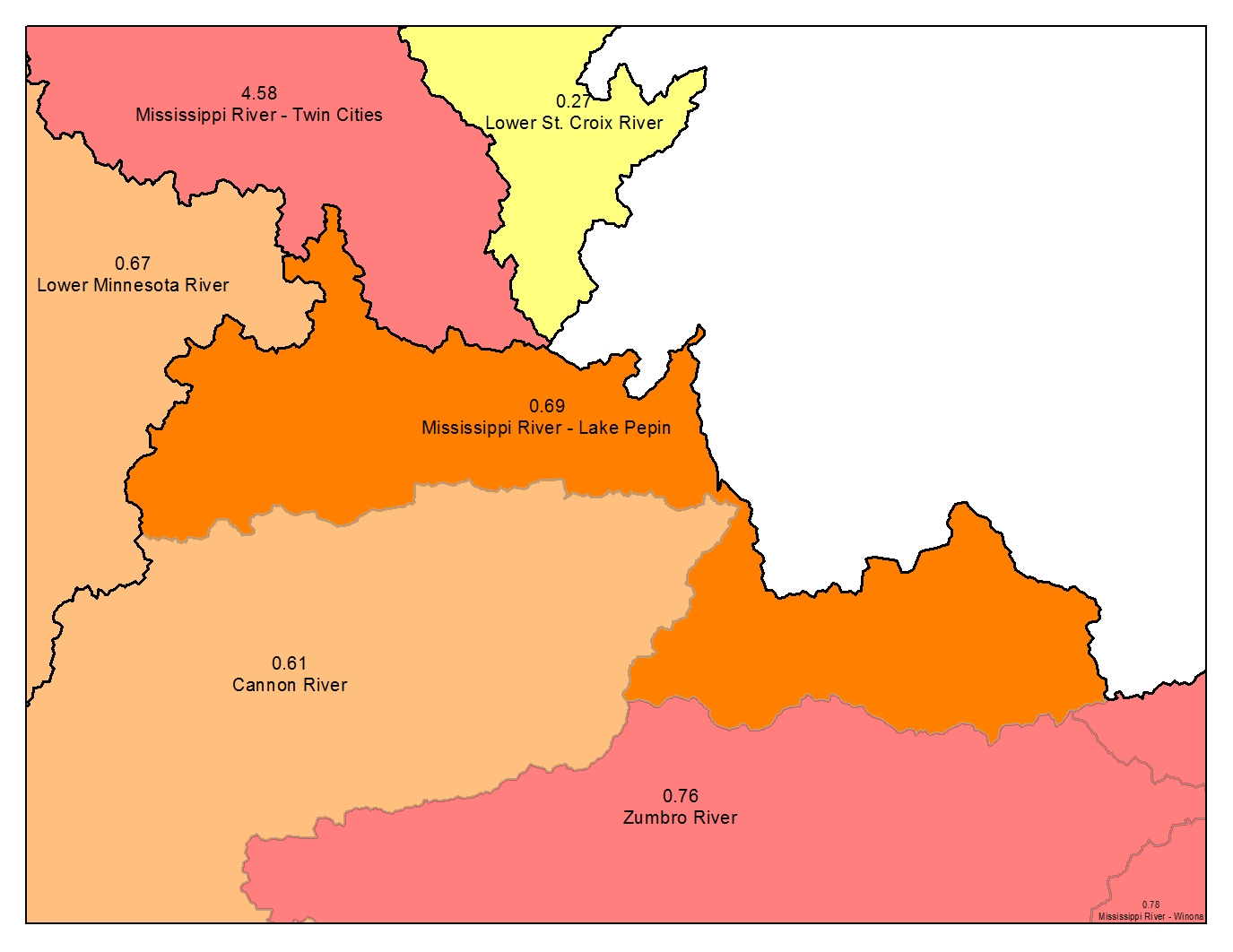 |
SPARROW flow-weighted mean TP concentration by HUC8 watersheds. The value represents the median FWMC of all subwatershed catchments within the HUC8 watersheds.
SPARROW Modeling for the Mississippi River-Lake Pepin Watershed indicated average flow-weighted mean TP concentration of 0.69 mg/l. This value represents the median FWMC of all subwatershed catchments within the Mississippi River-Lake Pepin Watershed FWMC.
Source: Minnesota Nutrient Reduction Strategy (2013)
Statewide
Implementation of MPCA’s Phosphorus Strategy and Minnesota Rule Chapter 7053.0255 has resulted in significant wastewater effluent phosphorus load reductions since the year 2000.
Statewide Wastewater Phosphorus Effluent Loading

Source: Minnesota Nutrient Reduction Strategy, Chapter 5: Point and Nonpoint Source Reductions
Municipal and Industrial Wastewater Phosphorus Trends & Projections
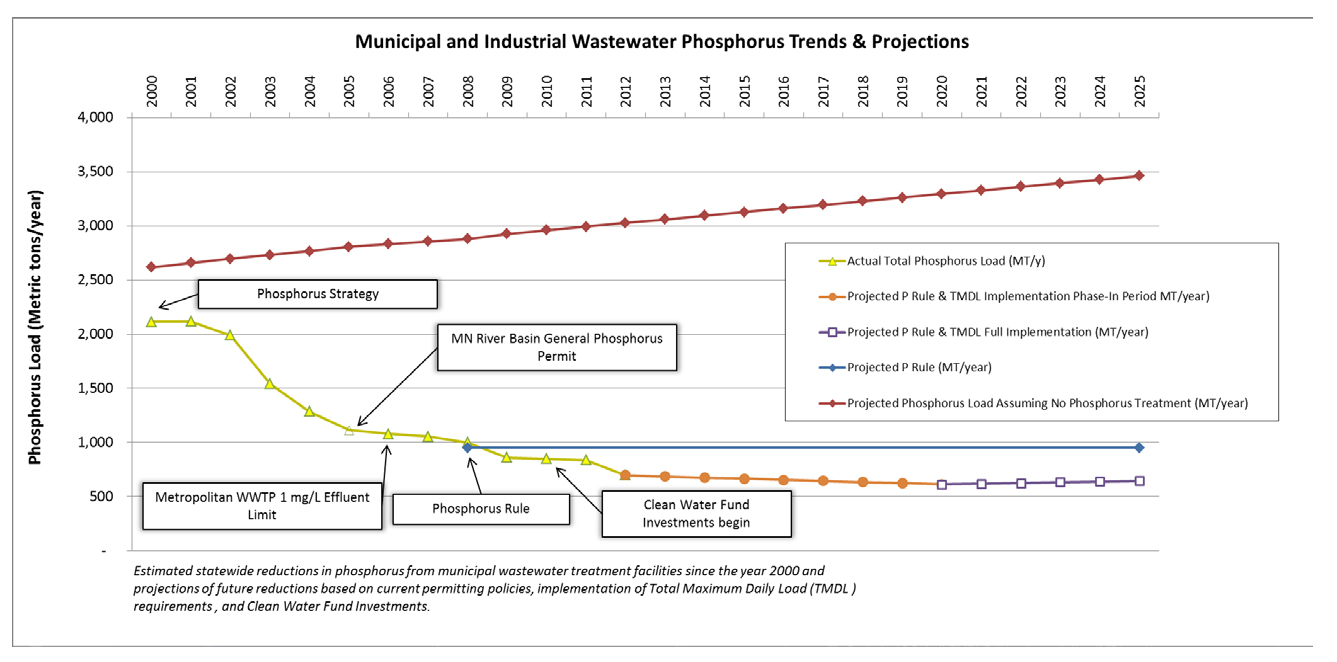
Source: Minnesota Nutrient Reduction Strategy, Chapter 4: Management Priorites and Recent Progress
Mississippi River Basin
Summary of Recent Progress in Phosphorus Source Loads by Major Basin
Efforts between 2000 and present have resulted in significant progress in reducing phosphorus loads in the Mississippi River Basin, due to both agricultural BMPs and wastewater treatment plant upgrades.
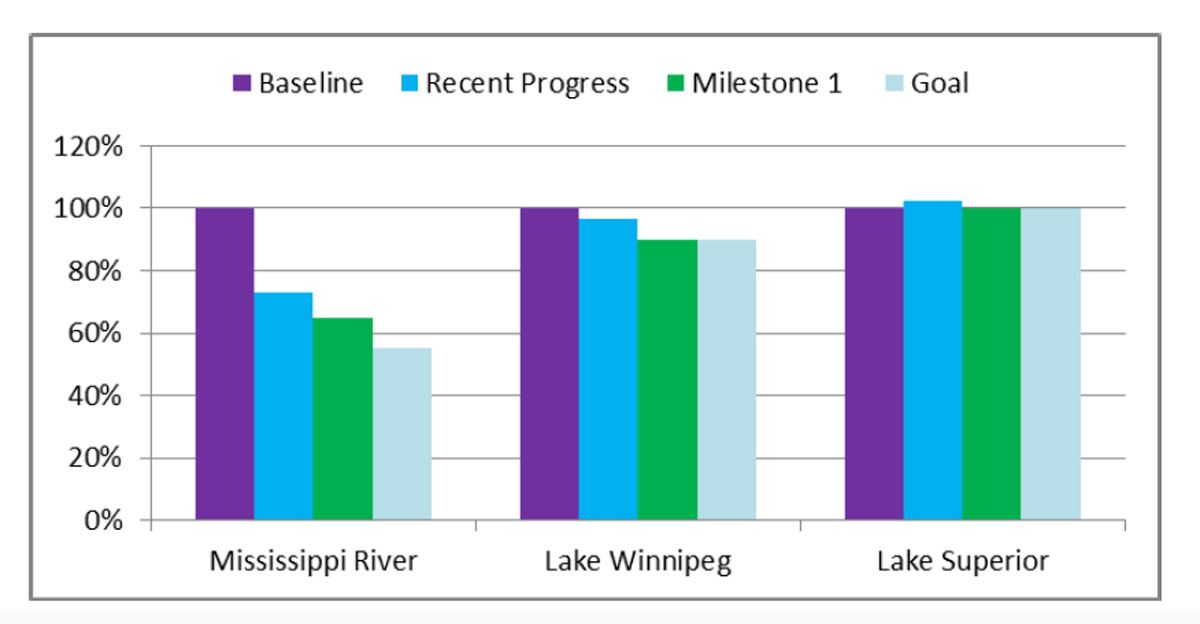
Source: Minnesota Nutrient Reduction Strategy, Chapter 4: Management Priorites and Recent Progress
Notes: Recent progress is the percent of baseline load remaining after accounting for reductions since 2000.
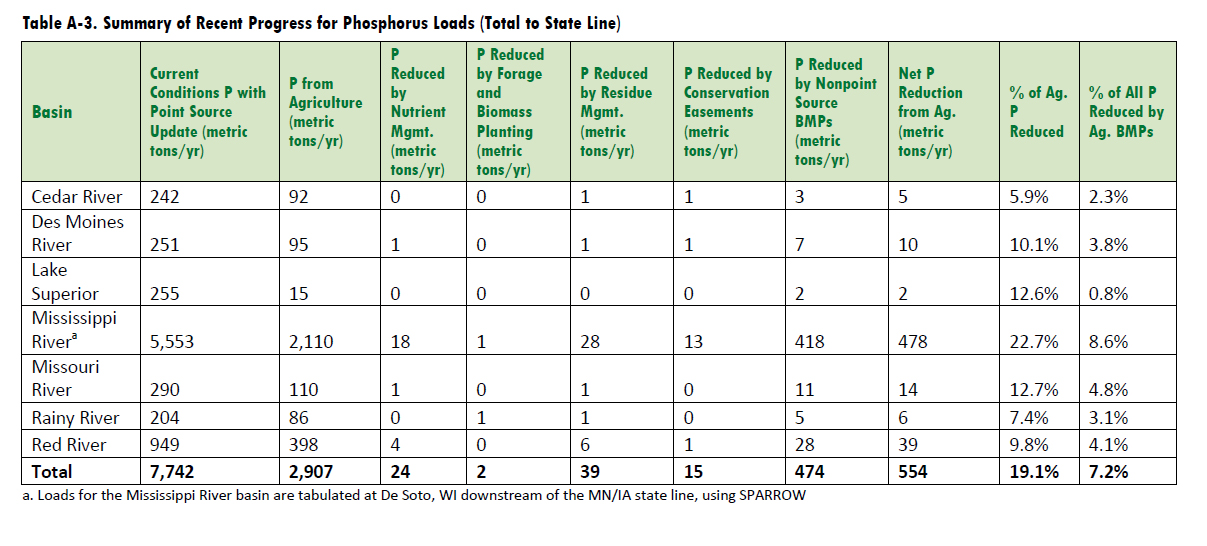
Source: Minnesota Nutrient Reduction Strategy, Appendix A
Assessed Lakes (2012) in the Mississippi River - Lake Pepin Watershed
Impairment Parameters:
Nutrients = Nutrients
HgF = Mercury in Fish Tissue
HgW = Mercury in Water Column
CL = Chloride
PCBF = PCBs in Fish
PFOS = Perfluorooctane Sulfonate (PFOS) in Fish Tissue
Affected Uses:
AQC = Aquatic Consumption
AQR = Aquatic Recreation
AQL = Aquatic Life
Source: Minnesota Pollution Control Agency Assessed Waters (2012) & Impaired Waters (2012)
Statewide Impaired Lakesheds
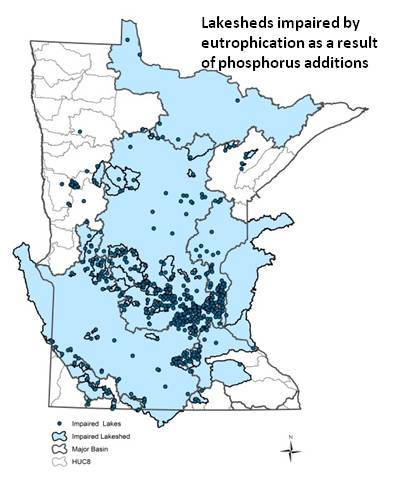
Source: Minnesota Nutrient Reduction Strategy, Chapter 2 Setting Goals and Milestones (2013)
For more information about what you can do to protect area lakes, visit MPCA's Lake protection and management website.
Vertical Tabs
 Watershed Contacts - MPCA
Watershed Contacts - MPCA
 Local Government Units and Partner Agencies - BWSR
Local Government Units and Partner Agencies - BWSR
Watershed Group
Lower Mississippi River Watershed Management Organization
(651)480-7778
Vermillion River Joint Powers Organization
14955 Galaxie Avenue
Apple Valley, MN 55124
BALMM
 Basin Alliance for the Lower Mississippi in Minnesota (BALMM)
Basin Alliance for the Lower Mississippi in Minnesota (BALMM)
MPCA Watershed Contact
Justin Watkins, Pollution Control Specialist Senior
Rochester Office
(507)206-2621
justin.watkins@state.mn.us
Brooke Asleson, Vermillion River – MPCA Coordinator
(651)757-2205
brooke.asleson@state.mn.us
Goodhue County
 Goodhue County
Goodhue County
 Goodhue County SWCD
Goodhue County SWCD
Scott County
 Scott County
Scott County
 Scott County SWCD
Scott County SWCD
 Scott County WMO
Scott County WMO
Wabasha County
 Wabasha County
Wabasha County
 Wabasha County SWCD
Wabasha County SWCD
 The Minnesota Nutrient Reduction Strategy - MPCA
The Minnesota Nutrient Reduction Strategy - MPCA
Driving forces and building blocks for the Nutrient Reduction Strategy
 Hypoxia Action Plan
Hypoxia Action Plan
 Clean Water Land & Legacy Amendment
Clean Water Land & Legacy Amendment
 Minnesota Watershed Approach
Minnesota Watershed Approach
 Groundwater Proection and Nitrogen Fertilizer Management Plan
Groundwater Proection and Nitrogen Fertilizer Management Plan
![]() Minnesota Water Sustainability Framework
Minnesota Water Sustainability Framework
 Detailed Assessment of Phosphorus Sources to Minnesota Watersheds
Detailed Assessment of Phosphorus Sources to Minnesota Watersheds
 Nitrogen in Minnesota Surface Waters
Nitrogen in Minnesota Surface Waters
 Modeled Nitrogen Loads (SPARROW)
Modeled Nitrogen Loads (SPARROW)
 Watershed Pollutant Load Monitoring - MPCA
Watershed Pollutant Load Monitoring - MPCA
Long Term Water Quality Monitoring -  USGS,
USGS,  Met Council,
Met Council,  Manitoba
Manitoba
Lower Mississippi River Basin
Lower Mississippi River Basin and Basin Alliance for the Lower Mississippi in Minnesota (BALMM)
Nutrient Management along the Lower Mississippi River (2011-2012)
Southeast Region
Land use, spatial scale, and stream systems: Lessons from an agricultural region (2005)
Water quality in relation to vegetative buffers around sinkholes in karst terrain (2006)
Agricultural contaminant source and transport in a karst groundwater basin (2007)
Winter Rye BMPs to Reduce Loads of Sediment and Nutrients to Minnesota Surface Water (2009-2013)
Characterizing Nitrogen Fertilizer Use on Manured Fields in the SE Karst Region 2010-2011
Geologic controls on groundwater and surface water flow in southeastern Minnesota and its impact on nitrate concentrations in streams (2013)
Accelerated Feedlot Technical Assistance (2013-2015)
Accelerated NPEA Engineering Assistance (2013-2015)
Metro
Estimating nonpoint source pollution for the Twin Cities metropolitan area using landscape variables (2006)
Metro Wide Subwatershed Stormwater Retrofit Analysis (2012-2014)
Stormwater Reuse Guide Outreach (2013)
Mississippi River – Lake Pepin Watershed
Watershed Restoration and Protection (MPCA)
Mississippi River – Lake Pepin Major Watershed WRAP Strategy (MPCA)
Rapid Watershed Assessment: Rush-Vermillion (NRCS)
Lake Pepin TMDL Project – Excess Nutrients (MPCA)
Long and Farquar Lakes TMDL Project – Excess Nutrients (MPCA)
Rapid Watershed Assessment: Rush - Vermillion
Lake Pepin Phosphorus Study, 1994-1998 (2002)
Diffusive and kinetic fluxes of phosphorus from sediments in relation to phosphorus dynamics in Lake Pepin, Upper Mississippi River (1999)
2005 Nutrient and Pesticide Management Assessment of Producers in the Middle Branch and South Branch Watershed of the Whitewater River
Historical changes in sediment and phosphorus loading to the upper Mississippi River: Mass-balance reconstructions from the sediments of Lake Pepin (2009)
Historical trends affecting accumulation of sediment and phosphorus in Lake Pepin, upper Mississippi River, USA (2009)
Longitudinal trends and discontinuities in nutrients, chlorophyll, and suspended solids in the Upper Mississippi River: Implications for transport, processing and export by large rivers (2010)
Mississippi River Lake Pepin Watershed Monitoring and Assessment Report (2012)
Vermillion River Watershed Monitoring and Assessment Report (2012)
Mississippi River-Lake Pepin Tributaries Biotic Stressor Identification (2013)
Lower Mississippi River Watershed Management Organization
LMRWMO Reports
LMRWMO Projects
Lower Mississippi River WMO Watershed Restoration and Protection Strategy (WRAPS) Project (MPCA)
Vermillion River Watershed Joint Powers Organization
Capital Improvement Projects
Watershed Plan, Standards, and Rules
Watershed Monitoring
Impaired Waters in the Watershed
Vermillion River Corridor Handbook
Vermillion River Watershed Restoration and Protection Strategy TMDL Project – Multiple Impairments (MPCA)
Lower Vermillion River Watershed Turbidity TMDL, Phase III: TMDL Development (2009)
Vermillion River Monitoring Network 2011 Report
Preventing Erosion to the Mississippi River Gully (2012-2014)
Vermillion River Watershed Monitoring and Assessment Report (2012)
Whitewater River Watershed Project
WRWP Programs
WRWP Reports & Events
WRWP Home
Goodhue County
County Watershed Projects
SWCD Programs
Feedlot Water Quality Management Grant Program - 2010-2011 2011-2012 2012-2014
SSTS Program Enhancement Grant Program (2010-2011)
The Minneola Project (2010-2011)
Nutrient Management along the Lower Mississippi River (2011-2012)
Southeast Minnesota Wastewater Initiative (2012-2014)\
Scott County
County Feedlot Program
SWCD Reports and Forms
WMO Programs & Projects
WMO Reports & Documents
Native Grasses and Filter Strips for Runoff and Pollution Reduction (2013-2015)
Cedar Lake and McMahon Lake TMDL – Excess Nutrients (MPCA)
Restoring Upper Porter and Picha Creeks (2010-2011)
Riparian Buffer Easement Program - Phase I (2010-2011)
Runoff Reduction Using Native Grasses (2010-2011)
Utica Ravine Stabilization (2010-2011)
Cedar Lake Shoreline Improvements (2011-2012)
Sand Creek & Prior Lake Spring Lake Wetland Restoration Project (2011-2012)
SSTS Imminent Health Threat Abatement Grant Program (2011-2012)
Cedar Lake and McMahon Lake Total Maximum Daily Load Implementation Plan (2012)
Riparian Buffer Easement Program - Phase II (2012-2013)
Using Native Grasses to Reduce Runoff – A Continuation (2012-2014)
Cleary Lake Regional Park Water Quality Retrofits (2013-2015)
Wabasha County
Annual Report
Programs and Services
Feedlot Information
Lake Pepin Phosphorus Study
Nitrate-Nitrogen Probability Map
Feedlot Water Quality Management Grant Program - 2011-2012 2013-2015
Nutrient Management Along the Lower Mississippi River (2011-2012)
Riparian Buffer Easement Program - Phase II (2012-2013)
Southeast Minnesota Wastewater Initiative (2012-2014)
Watershed Water Plan Summary
![]() Mississippi River-Lake Pepin Watershed Water Plan Summary
Mississippi River-Lake Pepin Watershed Water Plan Summary
Mississippi River-Lake Pepin Watershed
Percent of County in Watershed
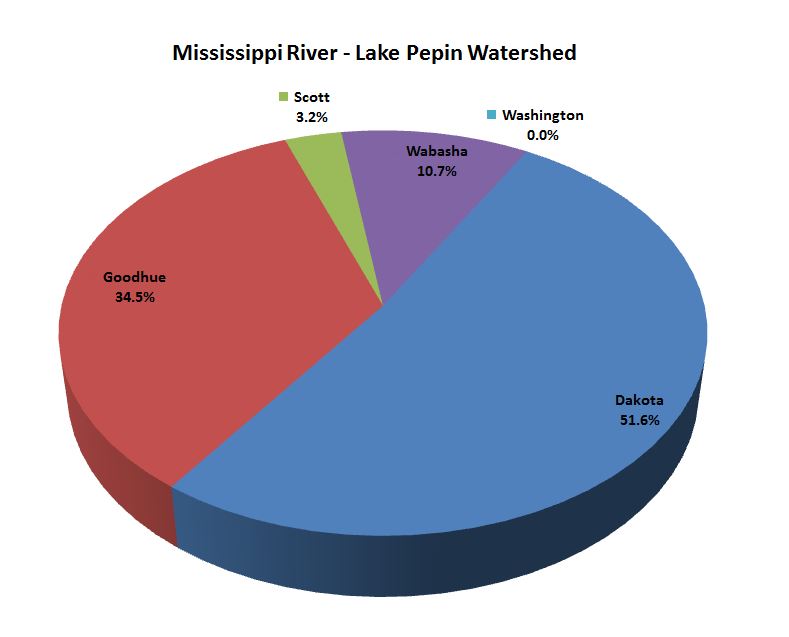
Water Plan Links
![]() Goodhue County LWMP 2010-2020
Goodhue County LWMP 2010-2020
![]() Lower Mississippi River Watershed Management Plan 2011
Lower Mississippi River Watershed Management Plan 2011
![]() Scott County Comprehensive Water Resource Management Plan 2009-2018
Scott County Comprehensive Water Resource Management Plan 2009-2018
![]() Wabasha County LWMP 2008-2012
Wabasha County LWMP 2008-2012
![]() Vermillion River Watershed Plan 2005-2015 amended 2008
Vermillion River Watershed Plan 2005-2015 amended 2008
Local Water Management Overview
 County Comprehensive Local Water Management - BWSR
County Comprehensive Local Water Management - BWSR
Minnesota Nutrient Strategy Overview
![]() Nitrogen Science
Nitrogen Science
![]() Strategies for Nutrient Reduction - Wastewater
Strategies for Nutrient Reduction - Wastewater
Planning Tools
 Minnesota Watershed Nitrogen Reduction Planning Tool - Nitrogen BMP Spreadsheet (Lazarus et al., 2013)
Minnesota Watershed Nitrogen Reduction Planning Tool - Nitrogen BMP Spreadsheet (Lazarus et al., 2013)
Nitrogen Priority Watersheds & Reduction Milestone
Nitrogen Priority Watersheds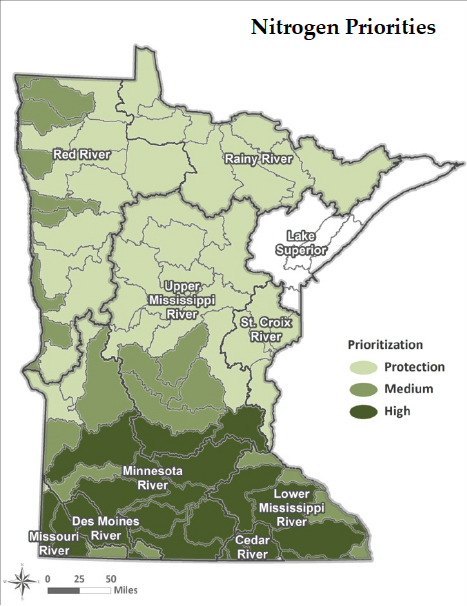 |
Reduction Milestone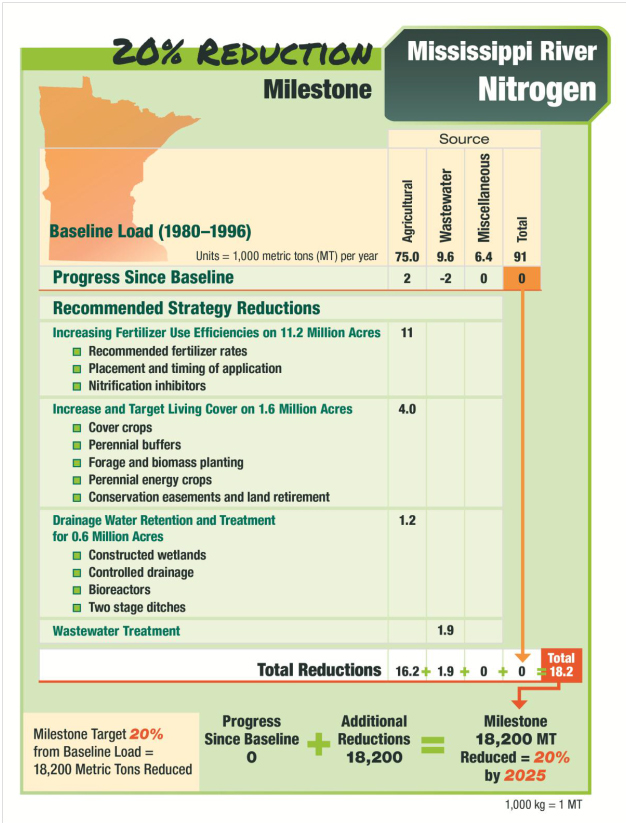 |
Source: The Minnesota Nutrient Reduction Strategy, Chapter 4: Management Priorities and Recent Projects (2013)
Priority Sources
Priority sources are determined on a basin scale, although it should be noted that different sources may be more or less important at the local scale. Priority sources at the HUC8 scale or smaller will be determined through watershed planning efforts at that scale.
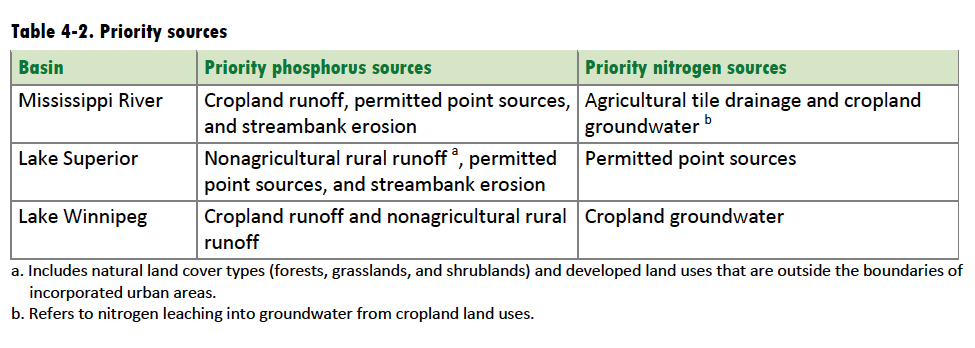
Source: The Minnesota Nutrient Reduction Strategy, Chapter 4: Management Priorities and Recent Projects (2013)
Example BMP Scenario for Nitrogen Reduction
 The Minnesota Nutrient Reduction Strategy - MPCA
The Minnesota Nutrient Reduction Strategy - MPCA
Excerpts from ![]() Chapter 5: Point and Nonpoint Source Reductions
Chapter 5: Point and Nonpoint Source Reductions
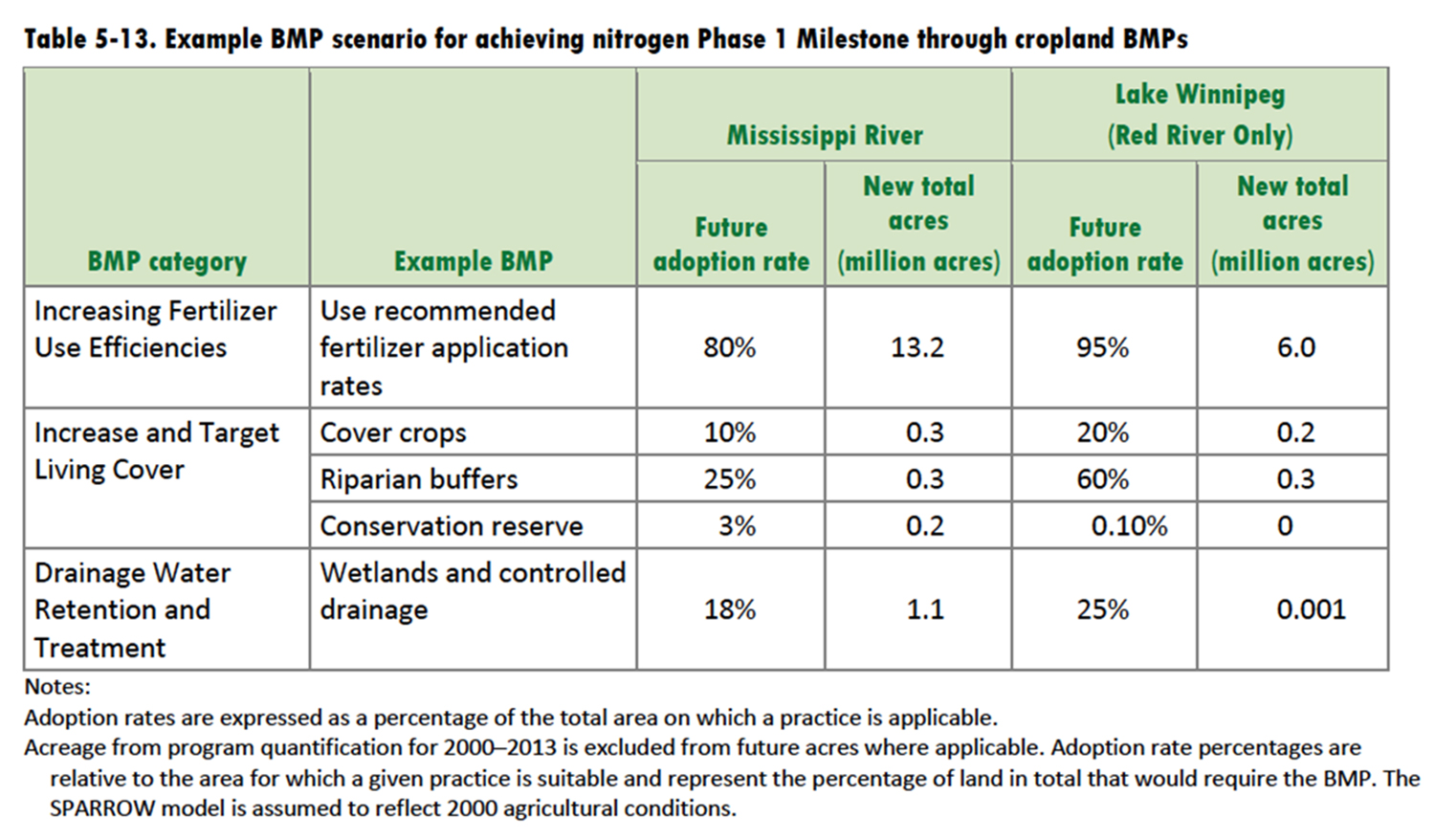
Source: The Minnesota Nutrient Reduction Strategy, Chapter 4: Management Priorities and Recent Projects (2013)
See "Economics" Tab for a Watershed BMP Nitrogen Reduction Scenario.
Minnesota Nutrient Strategy Overview
![]() Phosphorus Science
Phosphorus Science
![]() Strategies for Nutrient Reduction - Wastewater
Strategies for Nutrient Reduction - Wastewater
Phosphorus Priority Watersheds & Reduction Milestone
 The Minnesota Nutrient Reduction Strategy - MPCA
The Minnesota Nutrient Reduction Strategy - MPCA
Excerpts from ![]() Chapter 4: Management Priorities and Recent Projects
Chapter 4: Management Priorities and Recent Projects
Phosphorus Priority Watersheds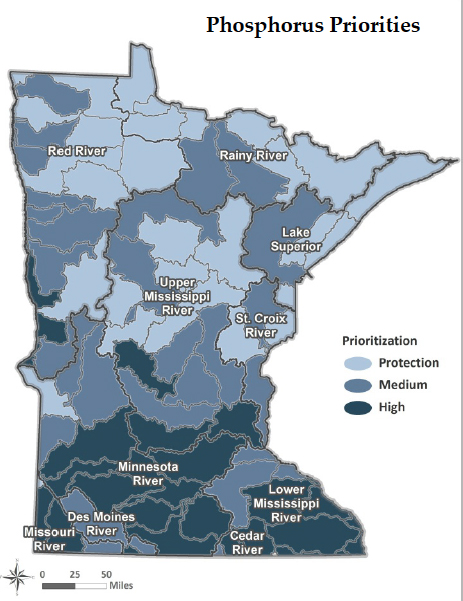 |
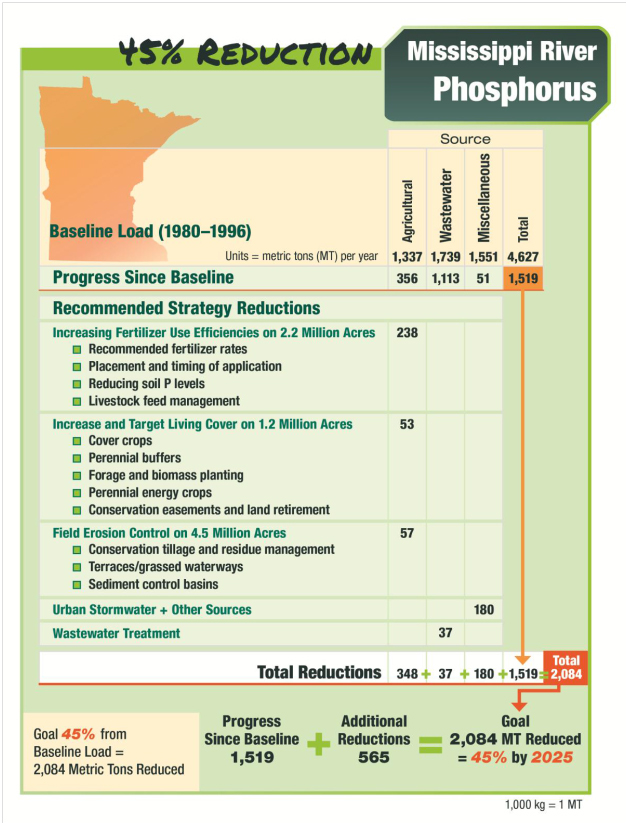 |
Source: The Minnesota Nutrient Reduction Strategy (2013)
Priority Sources
Priority sources are determined on a basin scale, although it should be noted that different sources may be more or less important at the local scale. Priority sources at the HUC8 scale or smaller will be determined through watershed planning efforts at that scale.

Source: The Minnesota Nutrient Reduction Strategy, Chapter 4: Management Priorities and Recent Projects (2013)
Agricultural BMPs
Example BMP scenario for Phosphorus Reduction
 The Minnesota Nutrient Reduction Strategy - MPCA
The Minnesota Nutrient Reduction Strategy - MPCA
Excerpts from ![]() Chapter 5: Point and Nonpoint Source Reductions
Chapter 5: Point and Nonpoint Source Reductions
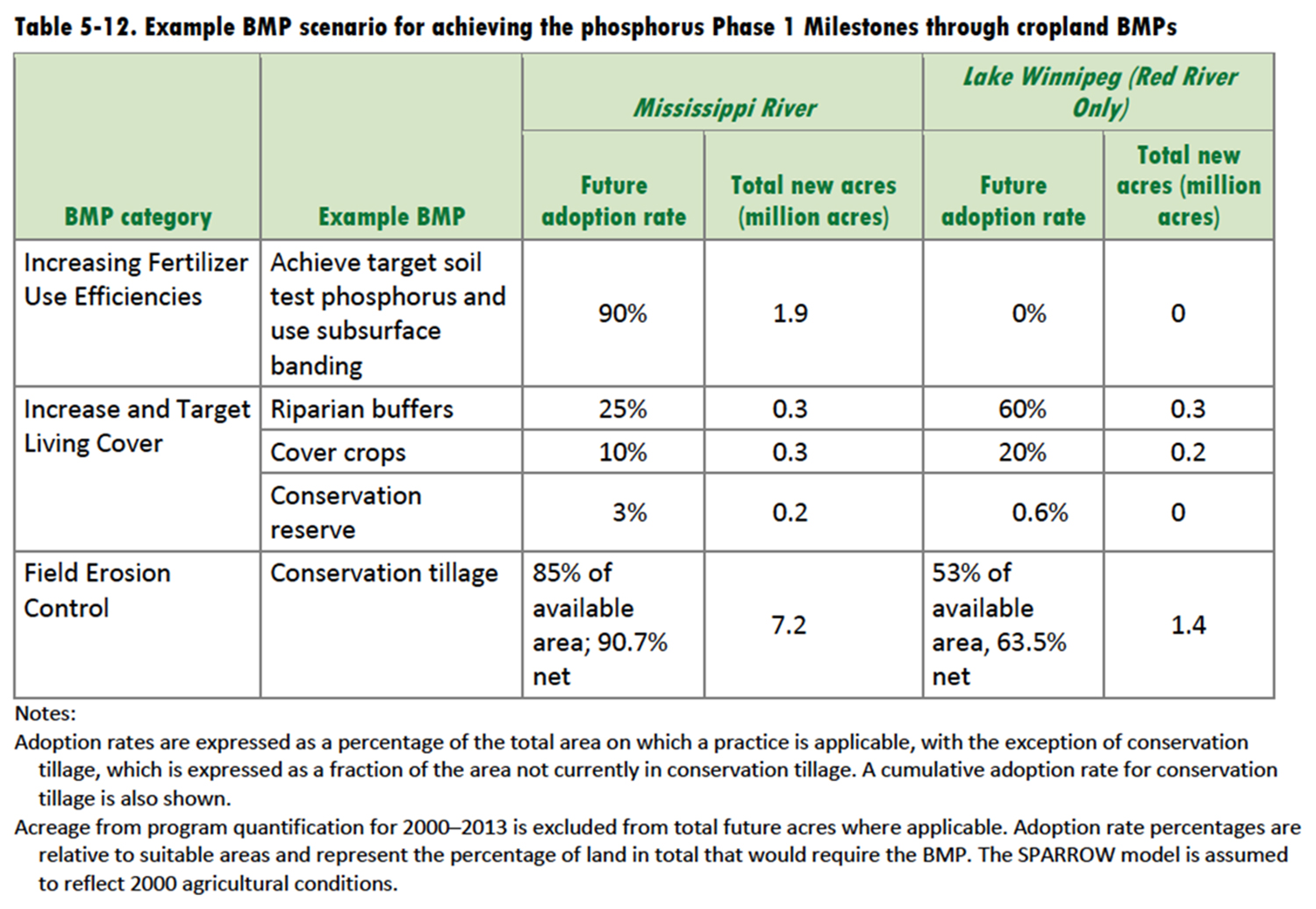
Source: The Minnesota Nutrient Reduction Strategy, Chapter 5: Point and Nonpoint Source Reductions (2013)
Watershed Summary
 Rapid Watershed Assessment Resource Profile: Rush-Vermillion - NRCS
Rapid Watershed Assessment Resource Profile: Rush-Vermillion - NRCS
 Completed Lake Pepin Legacy Alliance County Scorecard:
Completed Lake Pepin Legacy Alliance County Scorecard:
- Dakota
- Goodhue
- Scott
Conservation Practices
 Conservation Easements - BWSR
Conservation Easements - BWSR
 Conservation Implementation - BWSR
Conservation Implementation - BWSR
 Interactive Conservation Easement Map RIM - BWSR
Interactive Conservation Easement Map RIM - BWSR
 Conservation Practices - MDA
Conservation Practices - MDA
BMP Summary
Excerpts from  The Minnesota Nutrient Reduction Strategy - MPCA
The Minnesota Nutrient Reduction Strategy - MPCA
![]() Chapter 5 - Point and Nonpoint Source Reductions
Chapter 5 - Point and Nonpoint Source Reductions
![]() Appendix C - Agricultural BMPs
Appendix C - Agricultural BMPs
Because agricultural sources contribute the bulk of the statewide nitrogen load and a substantial portion of the phosphorus load, nitrogen and phosphorus reductions from agricultural sources are key to successfully achieving the milestones. Recommended agricultural BMPs and strategy options for promoting adoption of the BMPs to address phosphorus and nitrogen are provided in the links above.
Phosphorus: Based on the SPARROW model and the source attributions developed in the Detailed Assessment of Phosphorus Sources to Minnesota Watersheds (Barr Engineering 2004), agricultural sources contribute an estimated 38 percent of the statewide phosphorus load. A large part of the remaining phosphorus load is due to stream channel erosion, much of which is indirectly affected by agricultural runoff and intensive drainage practices (Schottler et al. 2013).
Nitrogen: Based on the Nitrogen in Minnesota Surface Waters study (MPCA 2013), agriculture contributes 73 percent of the statewide nitrogen load in a typical year.
See "Strategy - N Reduction" and "Strategy - P Reduction" Tabs for example BMP Scenarios for Nitrogen and Phosphorus Reduction.
![]() Agricultural Watershed Modeling: Zumbro and Maumee, Midwest Watershed Modeling GIS Workshop (Flynn & Redder, 2013)
Agricultural Watershed Modeling: Zumbro and Maumee, Midwest Watershed Modeling GIS Workshop (Flynn & Redder, 2013)
 Minnesota Watershed Nitrogen Reduction Planning Tool - Nitrogen BMP Spreadsheet (Lazarus et al., 2013)
Minnesota Watershed Nitrogen Reduction Planning Tool - Nitrogen BMP Spreadsheet (Lazarus et al., 2013)
 Minnesota Nutrient Reduction Strategy SPARROW - (MPCA, 2013)
Minnesota Nutrient Reduction Strategy SPARROW - (MPCA, 2013)
 Lake Pepin Watershed Full Cost Accounting SWAT, InVEST, Sediment Rating Curve Regression, and Optimization (Dalzell et al., 2012)
Lake Pepin Watershed Full Cost Accounting SWAT, InVEST, Sediment Rating Curve Regression, and Optimization (Dalzell et al., 2012)
 GSSHA Model – Agricultural Water Certification Program – GSSHA Model – (MDNR, In Progress)
GSSHA Model – Agricultural Water Certification Program – GSSHA Model – (MDNR, In Progress)
 USDA-NRCS Nutrient Tracking Tool – Tarleton State (Texas Example)
USDA-NRCS Nutrient Tracking Tool – Tarleton State (Texas Example)
NTT estimates the nutrient and sediment load leaving a farm field through surface water runoff and leaching below the rooting zone and can be used to quantify the water quality benefits of different agricultural management systems and conservation practices. Designed and developed by the USDA Natural Resources Conservation Service (NRCS), USDA Agricultural Research Service (ARS), and Texas Institute for Applied Environmental Research at Tarleton State University (TiAER), NTT is intended for use by agricultural professionals or others familiar with farm procedures and conservation practices.
 Ag BMP Assessment and Tracking Tool – Houston Engineering
Ag BMP Assessment and Tracking Tool – Houston Engineering
Solutions for improving impaired waters often rely on the use of agricultural best management practices (BMPs). The goal of this project is to collect and disseminate thorough and accurate information on the use and effectiveness of agricultural BMPs in the State of Minnesota. Stakeholders can use this information to inform, mock-up and track their BMP implementation strategies.
 AG BMP Database - Houston Engineering
AG BMP Database - Houston Engineering
The goal of the Ag BMP Database is to provide a comprehensive source of information on the application and effectiveness of agricultural BMPs within the State of Minnesota. The database was developed to hold information on BMPs that are commonly used in the State to address water quality impairments for: sediment, nitrogen, phosphorus, and bacteria.
Ecological Ranking Tools
 Watershed Health Assessment Framework - MDNR
Watershed Health Assessment Framework - MDNR
The Watershed Health Assessment Framework (WHAF) provides a comprehensive overview of the ecological health of Minnesota's watersheds. By applying a consistent statewide approach, the WHAF expands our understanding of processes and interactions that create healthy and unhealthy responses in Minnesota's watersheds. Health scores are used to provide a baseline for exploring patterns and relationships in emerging health trends.
 Ecological Ranking of Parcels for Prioritizing Conservation Activities – NRRI
Ecological Ranking of Parcels for Prioritizing Conservation Activities – NRRI
This site provides a mapping tool by which natural resource managers can visualize and interact with a high resolution map of the spatial data layers. Managers have the ability to specify the relative importance of habitat, soil erosion potential, or other components of the Environmental Benefits Index - a score which represents a summary of the above factors., and view how the ecological ranking of parcels changes under different scenarios.
http://beaver.nrri.umn.edu/EcolRank/
FUNDING GUIDES
 Conservation Practices - Funding Guide, MDA
Conservation Practices - Funding Guide, MDA
This Minnesota Department of Agriculture website provides an overview of financial and technical assistance for nutrient management.
 Conservation Funding Guide: Practice & Payment Information, MDA
Conservation Funding Guide: Practice & Payment Information, MDA
On this Minnesota Department of Agriculture website, you can select a conservation practice and compare payments.
COST ANALYSIS PLANNING TOOLS
Minnesota Watershed Nitrogen Nitrogen Reduction Planning Tool
 Minnesota Watershed Nitrogen Reduction Planning Tool - Nitrogen BMP Spreadsheet (Lazarus et al., 2013)
Minnesota Watershed Nitrogen Reduction Planning Tool - Nitrogen BMP Spreadsheet (Lazarus et al., 2013)
The Watershed Nitrogen Reduction Planning Tool (Excel Spreadsheet) was developed as part of the Nitrogen in Minnesota Surface Waters Study by researchers at the University of MInnesota and Minnesota Pollution Control Agency. The project purpose was to develop a framework for a watershed nitrogen planning aid that could be used to compare and optimize selection of "Best Management Practices" (BMPs) for reducing the nitrogen load from the highest contributing sources and pathways in the watershed.
 Overview of Nitrogen Reduction Planning Tool
Overview of Nitrogen Reduction Planning Tool
![]() NBMP Tool - Maps
NBMP Tool - Maps
![]() NBMP Spreadsheet (Excel)
NBMP Spreadsheet (Excel)
Cost Analysis of Minnesota Nutrient Reduction Strategy
An analysis of costs is provided in Chapter 5.5 of the Minnesota Nutrient Reduction Strategy for both wastewater nutrient removal and agricultural BMP implementation.
Excerpts from ![]() Chapter 5: Point and Nonpoint Source Reductions
Chapter 5: Point and Nonpoint Source Reductions
![]() Appendix C: Program Recommendations
Appendix C: Program Recommendations
Wastewater

Source: Minnesota Nutrient Reduction Strategy, Chapter 5: Point and Nonpoint Source Reductions, 2013
Agricultural BMPs
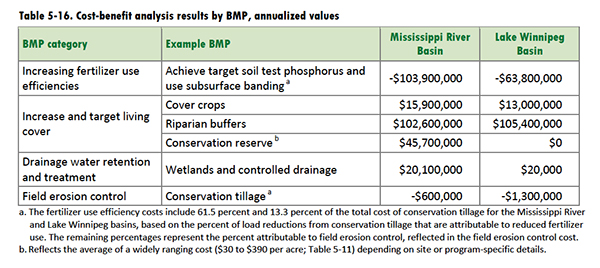
Source: Minnesota Nutrient Reduction Strategy, Chapter 5: Point and Nonpoint Source Reductions, 2013

